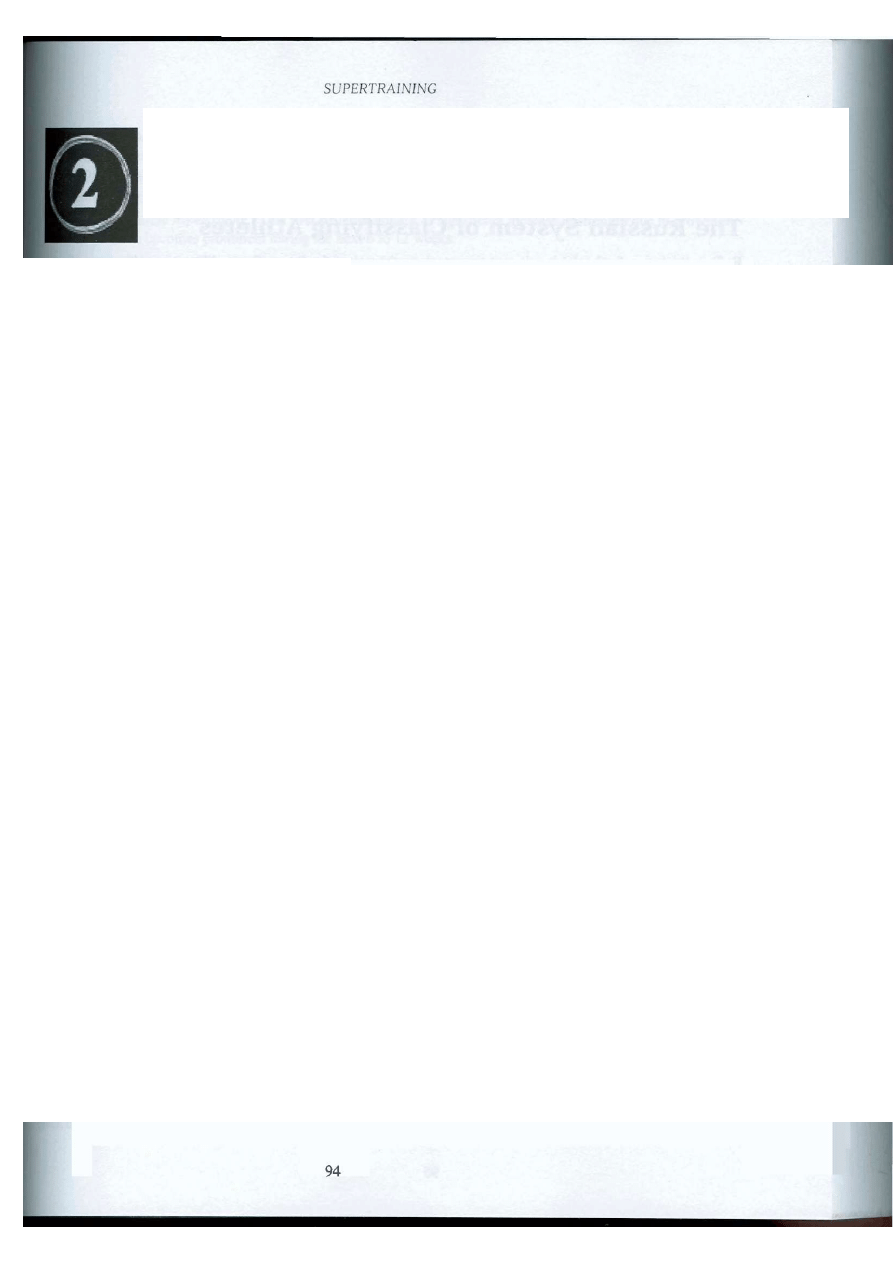
SPORT SPECIFIC
STRENGTH TRAINING
Special Strength Training
Strength training has become vital for successful sports preparation. However, it is only of value if a specific
methodolbgy can be devised on the basis of scientific research, detailing the role and place of strength conditioning
in the training process in the short and long term.
Regrettably, its historical links with physique training and the traditional view of muscle-bound gymnasium
patrons h a v e created the faulty impression that strength training retards athletic performance. Current emphasis
on research into heart disease and cardiovascular physiology has served to consolidate this view by popularising
the belief that fitness and cardiac health in general are well served by 'aerobic' or cardiovascular exercise and
endangered or minimally enhanced by training against resistance. The 'aerobics' community has confounded the
picture f u r t h e r by empirically categorising many strength conditioning exercises as dangerous and generally
regarding a e r o b i c activity as superior to all other forms of exercise.
It o f t e n seems to be forgotten that fitness is a complex state determined by several interacting components
(the fitness factors discussed in 1.14.3), each of which requires specialised training for optimal development.
Strength processes play a particularly important role in controlling the stability and mobility of the body in sport.
F o r t u n a t e l y , a sizeable community of'strength scientists' has emerged to challenge the above preconceptions
and examine the part played by strength and strength conditioning in human performance arid injury rehabilitation.
Some of their work is now revealing that muscle strength and endurance may play key roles in ensuring superior
performance even during long duration events such as marathons. For instance, research into the biomechanics of
I the soft tissues has indicated that performance in distance running also may be enhanced by (Siff, 1986):
• ¡Improving the ability of the SEC (series elastic component) of the muscle complex to store and release
• Modifying running technique to improve the ability of the athlete to utilise the stored elastic energy and to
•¿spare muscular energy.
Kfflerailed in Chapter 1, the mechanical properties of connective tissues (such as elasticity, strength and damping
ratio ),|as well as neuromuscular efficiency (discussed in later chapters), can be beneficially altered by using
The striking success achieved by Russian and Eastern European coaches in applying specialised strength
training in preparation for most sports has also stimulated the rest of the world to take this type of conditioning
far more seriously. Considerable experience has now been gained in the use of special strength training to facilitate
adequate analysis and identify some general principles. However, it has been insufficient to form a definitive
methodological foundation for the special strength training of athletes. The role and place of special strength
training can be established only through scientific research in two main directions:
• Further study of the principles governing the general conditioning of the body to determine scientific means
of achieving one's physical potential
• Intensive study of the principles determining the specific long-term sports training process.
Scientific research in the first direction already has yielded a wealth of information, whereas serious work in the
second direction has commenced only recently, so that its findings are still rather limited. Nevertheless, they
enable one to formulate important principles concerning special strength training, where the latter term refers to
the specialised application of strength training to sport. It is synonymous with sport specific strength training,
and both expressions may be used interchangeably to distinguish it from general weight training or bodybuilding for
At the outset, it must be emphasized that the phenomenon of strength should not be viewed simplistically in
terms of the classical definition as 'the ability to produce force by action of the muscles'. Strength is highly context
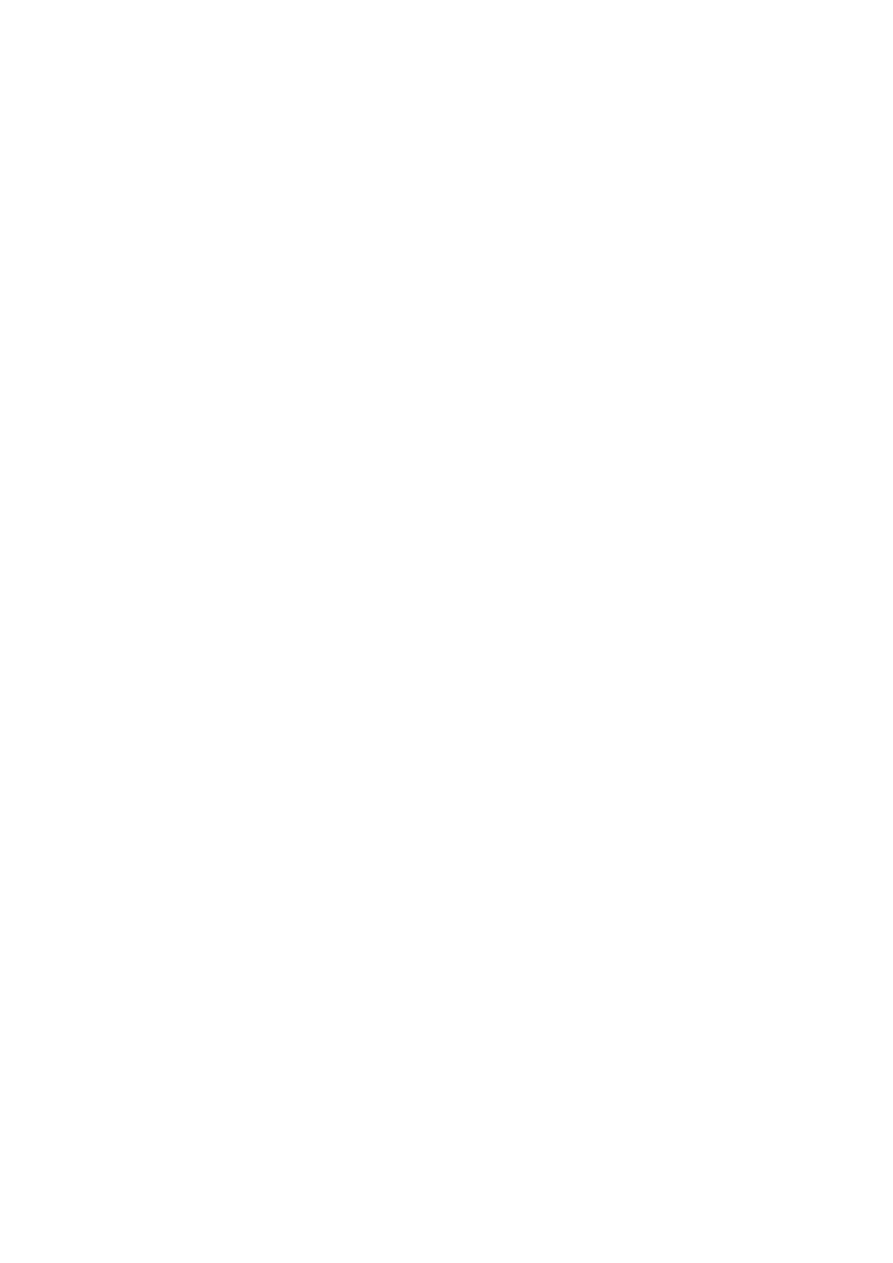
dependent. This point will be stressed throughout this book, since strength can manifest itself in many forms, such
as static strength, dynamic strength, strength-speed and strength-endurancc. The accurate modelling of the
strength and other fitness characteristics of a particular sport is what transforms general strength training into
special strength training to produce consistent improvement in sports performance.
The Russian S y s t e m of Classifying Athletes
Before going any further, it is relevant to remark on the use of the terms Sports Mastery or Mastery in Sport.
These terms have been used for many years in Russia and Eastern Europe to describe the process of reaching the
They are also closely related to the categorisation scheme used to identify athletes of different qualification.
In this scheme, competitors at the most basic level fall into Class III, athletes of intermediate standard into Class
II, and advanced athletes successively into Class I, Candidate for Master of Sport, Master of Sport, Candidate for
International Master and International Master (or, Master of Sport, International Class). The last two categories
refer to athletes such as world record holders, world champions and world champions of several years' standing.
Specific norms are set for all individual and team sports, based on times, distances, scorcs, lifts, number of times of
selection at a given team level or special achievements. The classification system does not rank beginners, since
It is one of the objectives of th ook to present information which will assist the athle to progress via the
use of appropriate and effective strength training through all the stages of Mastery to the highest possible level
It should be noted that the Russian system of classifying athletes begins not with formal competitions, but
with the GTO (Readiness for Work and Defence) badge, which recognizes the minimum standards of physical
fitness for anyone in the population. The GTO norms apply to children from about 10 years of age and progress
into late adulthood (over 65 years of age). The GTO tests involve several sports and serve to identify levels of
athletic prowess in the formative years. Those whose intention is to progress beyond the GTO IV, III, II and I
badges have to pass more rigorous requirements to lead them through the various Classes of Mastery as detailed
above. Before one reaches the adult classification system, there are also junior rankings (Class III up to Class I) for
The classification of athletes should not be regarded as a regimented system with strict application only in the
Russian context, but a fundamental principle for the scientific preparation of athletes in all countries. Since
athletes of different levels of proficiency and training experience respond very differently to strength conditioning
prograiv• •?, it is vital that competitors be periodically tested and graded to enable coaches to set up the most
approp training regimen for each individual during a specific phase of development.
The Early Stages of Strength Training
A few remarks are necessary about the early stages of strength training. Virtually any methods of strength training
will enhance the strength of a novice during the first few months, provided the intensity, in particular, is kept at a
safe level. This is a major reason why it is misleading and counterproductive to apply the results obtained from
scientific studies of less than at least six months' duration. It is also a major reason why relatively inexperienced
coaches manage to have initial success with athletes and thereby continue to attract clients. Moreover, it has been
discovered that each individual displays a different rate, degree and ejficiency of responding to the same type,
quality and quantity of physical training. In other words, the identical training programme will have different
effects on different people. The achievement of higher levels of mastery is a complex process which requires the
careful application of the appropriate means and methods of training at the different stages of sports preparation
In approaching strength training for the first time, it is important to remember that the increase in strength in
relative newcomers is due primarily to a learning effect which is neuromuscular in nature. Such increases in
strength related to performance factors such as the improvement in skill in executing a specific exercise can even
take place within the first training session. This type of improvement generally will be experienced with any
exercise which is novel to the user. After that, strength changes occur in the following typical pattern (though the
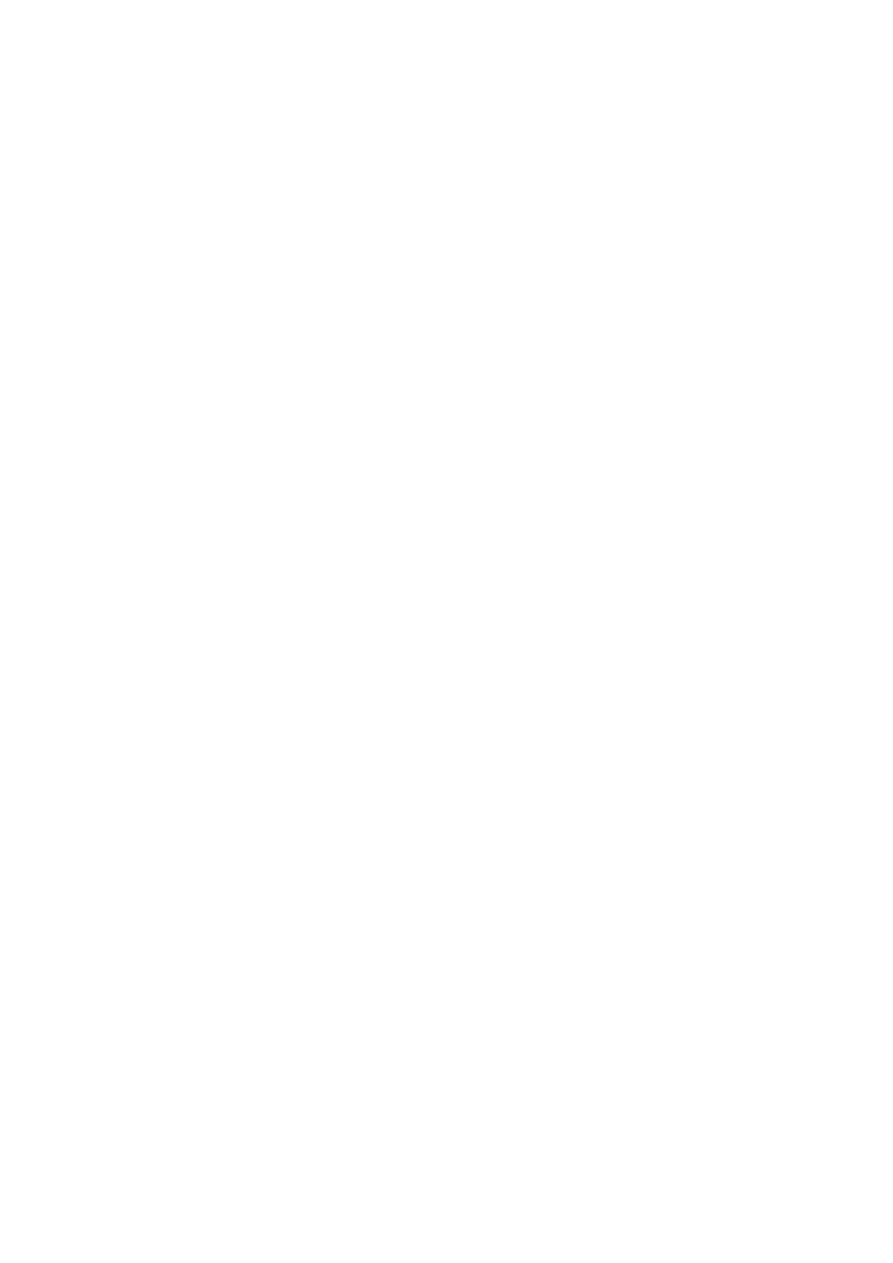
S UPERTRAINING
Increase in intermuscular coordination. This functional improvement in the overall co-operation among
different groups of muscles takes place over the first 2-3 weeks of training.
in intramuscular coordination. This next functional improvement, caused by enhanced cooperation
continue for the following 4-6 weeks.
3. Increase in muscle hypertrophy. This first structural phase of significant increase in strength due to growth in
muscle tissue becomes prominent during the next 6 to 12 weeks.
4. Stagnation. The rate of improvement for functional and structural reasons now decreases markedly. For
continued progress, it now becomes necessary to determine whether the stagnation is due to neuromuscular
or muscle growth factors and then modify the training programme accordingly. At this point, the knowledge
of a highly skilled coach becomes necessary, especially as haphazard trial-and-error programmes initiated at
the onset of the stagnation phase can diminish overall sports performance and lead to pain or injury.
Earlier sections of Chapter 1 (especially 1.6) and the immediately preceding section relate increases in strength to
two broad physiological processes, namely hypertrophy and neural adaptation. More detailed analysis has
associated more strength gain with hypertrophy of type II muscle fibres, with further information on changes in
the differenf ypes of muscle fibre due to activation or inactivity appearing in Section 1.12.
Some caution is necessary before one overemphasizes the role of neural adaptation at the expense of other
possible mechani ns of strength increase. Gains in peak force or joint torque after strength training have been
documented in the absence of any changes in neural drive, as shown in studies which relied on training with
electrical stimulai >n of the motor nerve or muscle, a process which ensured that the observed adaptations in peak
torque were independent of neural, learning or motivational effects.
Even though a relatively amateurish approach may produce strength increases during the first year of training,
this may n >e entirely beneficial to the athlete, because the improvements may «j/^ie sufficiently sports specific.
From the beginning, it is vital to identify exactly which strength-related qualities (such as speed-strength, skill-
endurance or strength-endurance) need to be enhanced in a given individual executing a specific series of tasks in a
particular sport. Both short- and long-term progress has to carefully planned if the path to Sports Mastery is to
be effici and largely injury-free.
2.1 S c h e m e s for Perfecting M o v e m e n t s
Athletic performance may be iescribed in terms of a complex interaction of many movements, so that the
fundamental phenomenon underlying all sports tasks is movement. Sport then becomes a problem-solving activity
in which movements are used to produce the necessary solutions. These movements are controlled by the
neuromuscular system, whose performance is the result of innate characteristics and the long-term acquisition of
skills through training.
The perfecting of athletic movements during long-term training is realised primarily by enhancing the
efficiency of the neuromuscular system to competently solve specific motor tasks. The ability to effectively use
one's motor otential to achieve success is the essence of sports mastery. This ability is realised by means of a
specific : f movements, the composition and organisation of which are determined by the type of athletic
activity < 1 the rules of competition. The sports training process as a whole is a phenomenon of exceptional
complexity. In the context of this book, it is therefore appropriate to limit the study largely to those training
schemes which relate most directly to muscular strength and the kinesiologies organisation of movement in space
and time, namely:
• Increasing the working effect of movements
« Perfecting the motor pattern of movements
• Perfecting the kinesiological pattern of movements.
2
.1 1 Increasing the Working Effect of Movements
The working effect of a movement is the result of interac an with objects in the environment, where speed and
direction of movement depend upon the character of the force developed.
If the movement is to be analysed mathematically, then the force developed at any instant, F(t), may be
depicted graphically (see Fig 2.1). In almost all athletic movements the beginning and end of the force curve lie on
the ho xis, because the movement begins and ends with zero velocity. The working-effect of the effort is
given by the area under the curve F(t) over the time interval t during which the weight W is overcome (the shaded
96
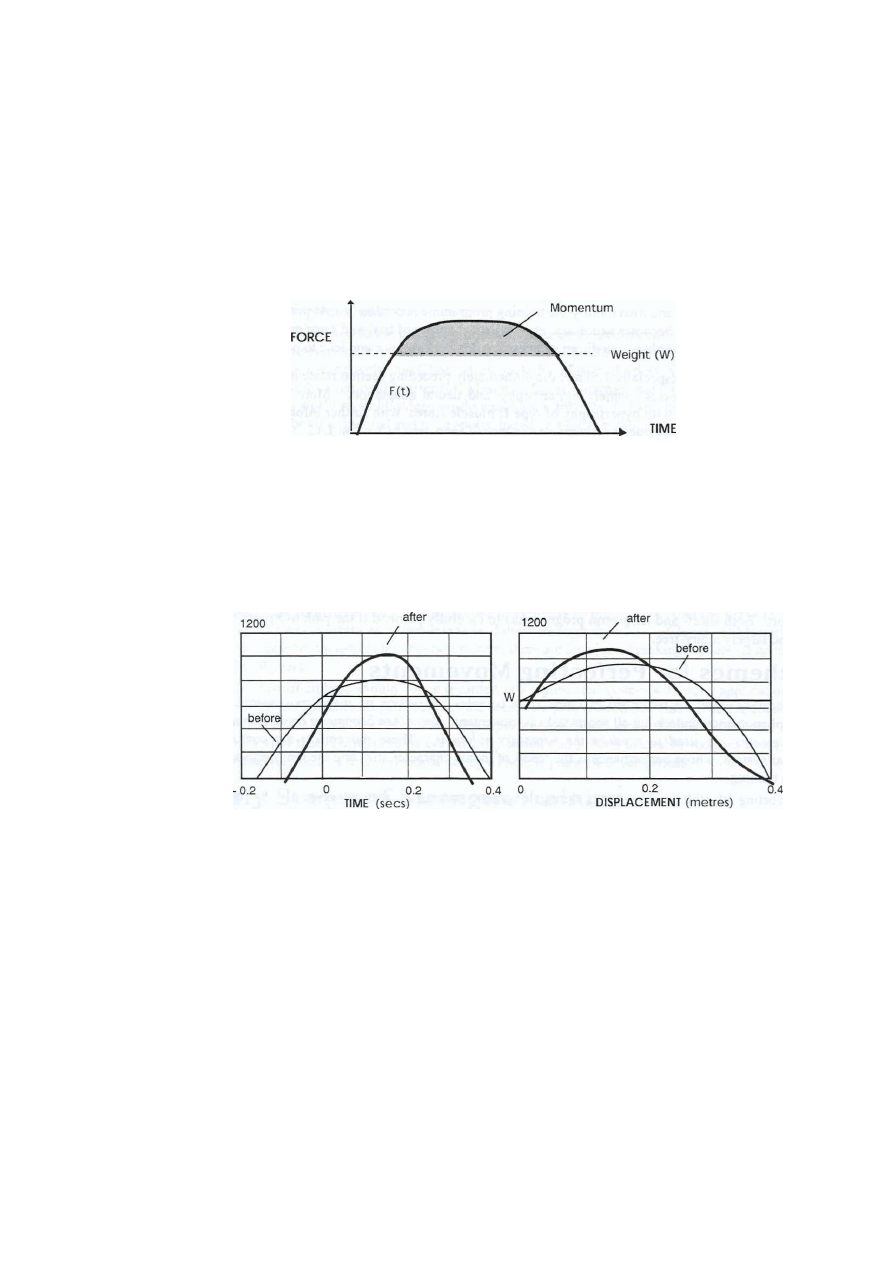
S UPERTRAINING
area) or as the integral p = / F(t).dt, where p is the momentum (m.v) of the body attained over that interval (see 5.1
for definitions and derivations). An increase in the working-effect of the movement is achieved in principle by
increasing this area (i.e. its momentum). This, in brief, is one of the major goals for perfecting athletic movements.
Other major goals include increase in the maximum force (the peak of the F(t) graph), increase in the rate of
maximum force production (the upward slope of the F(t) graph in Fig 2.1), and production of maximum 1 e at
the appropriate instant. When a force is applied explosively over a very brief time interval, the resulting rapid
change in momentum is known as the impulse of the force (detailed in 5.1).
Figure 2.1 Force - time curve for a weight W being overcome by a force F(t)
As sports proficiency increases, the pattern of the effort produced undergoes specific changes in space and time
which can be clearly displayed even within a relatively short period of training. For example, the graphs describing
explosive force, F(t) and F(s), obtained before and after 6 months of training respectively are shown in Figure 2.2,
produced by an individual for a leg movement in the seated position. F(t) refers to the force as a function of time
and F(s), the force as a function of displacement.
FORCE (N) FORCE (N)
Figure 2.2 The force-time, F(t), and force-displacement, F(s), graphs for explosive force, before and after 6 months of strength training.
W is the weight being overcome (Siff & Verkhoshansky, 1999).
Their coincidence on the vertical axis corresponds to the instant when the magnitude of the force is equa to the
weight of the load displaced. F(t) graph displays several features:
• there is a decrease in the time taken to produce maximal force
• there is an increase in the maximum force
• maximum effort is produced at a point closer to when muscle tension begins
• there is a decrease in the general duration of the effort.
The changes in the profile of the graph reflect the general patterns in perfecting sporting movement which were
identified in research with athletes of different specialisation and qualification using different regimes of muscular
work, as well as with the same athlete during training over different lengths of time (Verkhoshansky, 1977). The
experimental results show that, during long-term training, the perfecting of athletic movement proceeds as follows
(Fig 2.3):
1. Initially there is a relatively uniform increase in force (compared with the initial level of curve 1), with an
insignificant decrease in its duration (Fig 2.3a, curve 2)
97
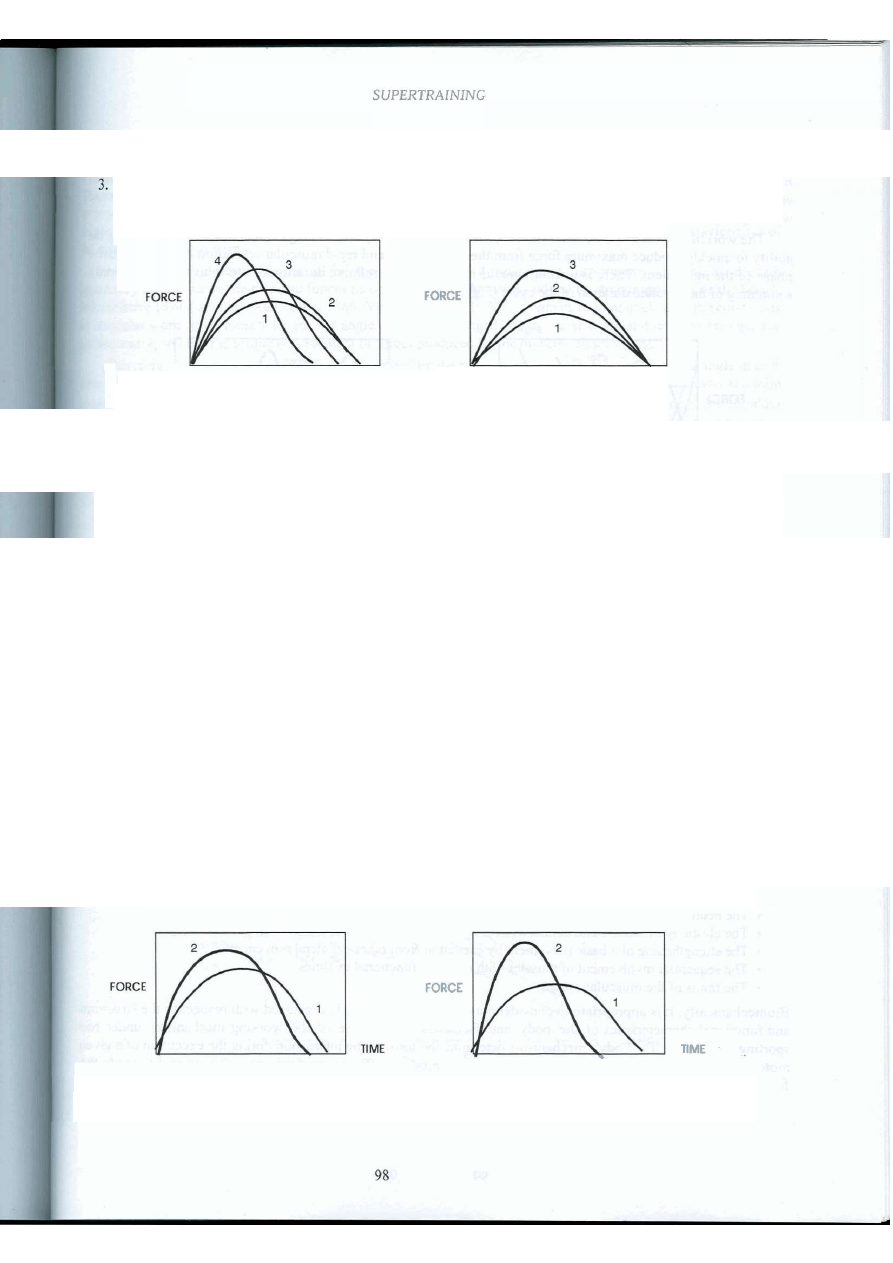
2. There is then a significant increase in maximum force and a noticeable decrease in the duration of the
movement (Fig 2.3a, curve 3)
Finally, there is an increase in the force developed at the beginning of the effort, with some increase in its
maximum and a decrease in the time taken to reach the latter (Fig 2.3a, curve 4).
(a) Force - time graph (b) Force - displacement graph
Figure 2.3 Changes in F(t) and F(s) during training (details are described in the text). (Verkhoshansky, 1977).
The change in the dynamics of an athletic movement, relative to its working amplitude, follows a regular sequence,
namely (Fig 2.3b):
1. The movement initially displays a flattened distribution of force over much of the working range, which is
associated firstly with insufficient strength and, secondly, with the inability to use it efficiently (curve 1)
2. Next, with exercise, the maximum dynamic force increases and tends towards localised peaking in the
working range, whose location depends upon how the movement tasks are resolved (curve 2).
3. In ballistic types of speed-strength movement against relatively small resistance, the force is concentrated
near the beginning of the working amplitude (curve 3).
The force near the beginning of the movement is produced to a smaller degree when the resistance is large. In this
case there is a tendency to develop force quickly, although the high initial inertia decrees that maximal force cannot
be displayed with minimal delay. There is then some increase until it reaches a maximum near the middle of the
second part of the working range.
Thus, the perfecting of the working effect is associated with the production of a large maximum force over a
shorter period of time. This finding by Verkhoshansky, (1961, 1963) is corroborated by studies of the dynamics
of movements of athletes of different qualification (Papysheva, 1966; Gomberazde, 1970; Semyenov, 1970;
Tatyan, 1974).
It must be remembered that different regimes and external conditions of muscular work in athletics
undoubtedly influence this pattern. Thus, in movements associated with overcoming significant external
resistance (as in gymnastics, wrestling and weightlifting), the perfecting of the working-effect is realised primarily
by an increase in the maximum force developed and some decrease in the time taken for its production (Fig 2.4).
In ballistic movements, fencing, and some aspects of throwing, perfecting of the working-effect is associated
with concentration of force near the beginning of the movement. With this significant increase in maximum force, it
shifts closer to the beginning of the movement and takes less time for its achievement (Fig 2.5).
Figure 2.4 Displacement in force during explosive isometric
contraction before training (1) and after training (2). (Siff &
Verichoshansky, 1999).
Figure 2.5 Displacement in force during a ballistic
movement before training (1) and after training (2)
(Siff & Verkhoshansky, 1999).
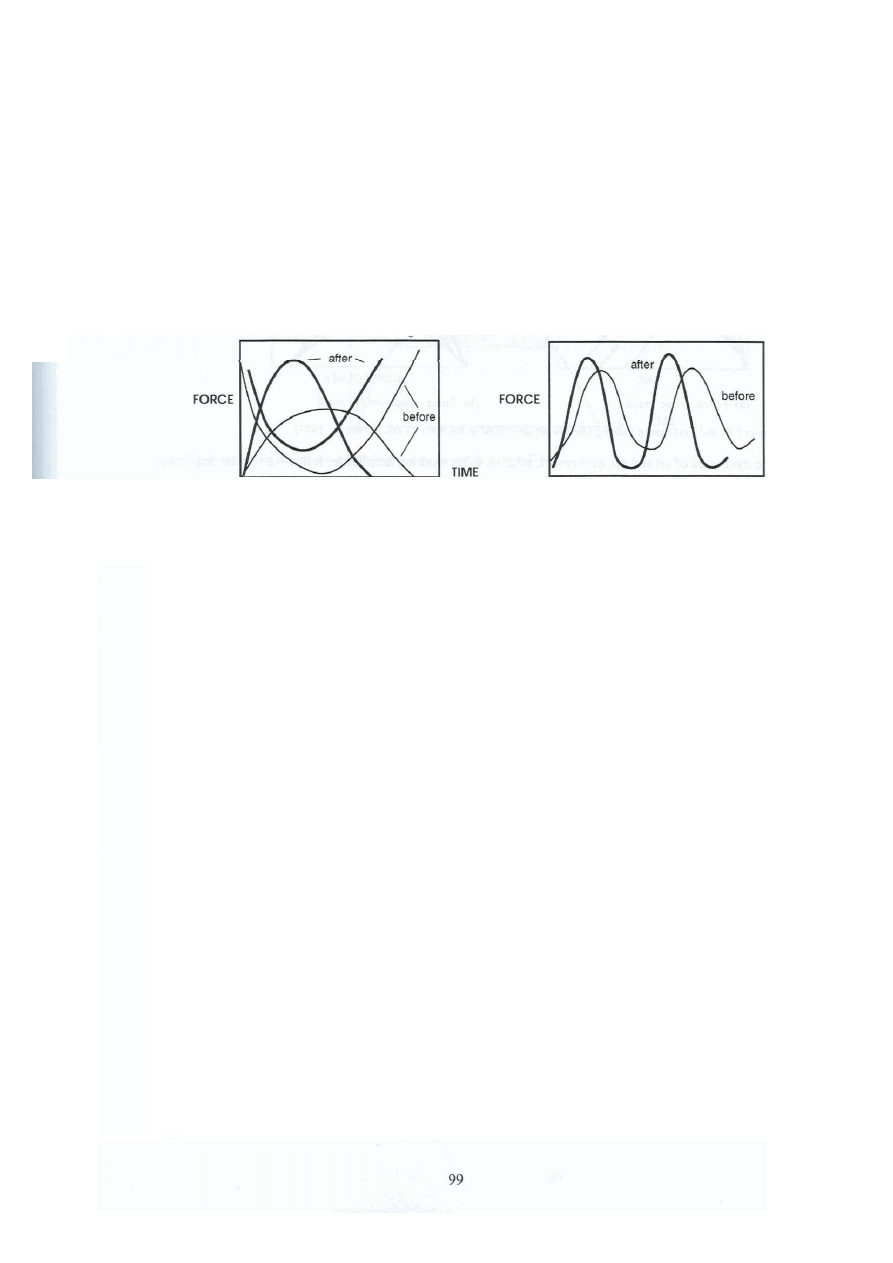
SUPERTRAIN1NG
In exercises involving a combination of muscular work regimes, the working force is preceded by a phase of
muscular stretching (e.g. jumping in track-and-field, figure skating and acrobatics). Thus, the perfecting of the
movement is achieved by improving the ability of the muscles to generate great force during the transition from
eccentric to concentric work. This rapid transition from stretching to contracting causes some decrease in the
working amplitude, i.e. there is a decrease in the angle of the working joint during flexion (Fig 2.6).
The working-effect in cyclic exercises {e.g. running, swimming and rowing) is increased by improving the
ability to quickly produce maximum force from the state of deep and rapid muscular relaxation during the passive
phase of the movement. There is a simultaneous increase in the relative duration of the relaxation phase and a
anale-
TIME
- force-
Figure 2.6 Variation in dynamic force & angular displacement for
reactive-ballistic movement before and after training (Siff &
Verkhoshansky, 1999).
Figure 2.7 Dynamics of a cyclical movement before and
after training (Siff & Verkhoshansky, 1999).
Thus, during the course of achieving sports mastery, the process of increasing the working-effect of the it
is independent of the regime, while the external work of the motor apparatus displays a specific pattern. s
• an increase in maximum force
• displacement of the instant of maximum force closer to when muscle tension begins
• an increase in the working amplitude of the movement
• a decrease in the time of production of the force.
In each case, the magnitude of these changes is specific to the type of sport involved.
2.1.2 Perfecting the Motor Pattern of Sports Movements
The effectiveness of movement is associated primarily with the appropriate use of the working mechanisms of the
body. This produces mechanical energy for effective use in response to external conditions. Such working
mechanisms are complex and are largely inherited by each individual. Sports training adds nothing new to them
but only directs them to a high level of proficiency, improves their coordinated use and increases energy
• The contraction of muscles transformed into external force via limb leverages
• The synergism and antagonism of muscle groups at the joints and in the musculoskeletal system as a whole
• The neuromuscular reflexes
• The elasticity of muscle and connective tissue which stores and uses elastic energy
• The strengthening of a basic movement by excitation from other collateral movements
• The sequential involvement of muscles with different functional qualities
• The tonus of the muscular system.
Biomechanically, it is appropriate to consider a motor complex which is organised with respect to the stru iiral
and functional characteristics of the body and facilitates optimal use of the working mechanisms under
sporting conditions. The body's mechanisms determine the form of the interaction during the execution of a given
motor task and how systematic training uses them to produce efficient performance. It is useful to study
functional properties of the body's mechanisms and how they enhance specific performance at the following evels
• The level of the kinematic pair (two actively combined adjacent links)
The level of the kinematic chain (the sequential combination of several links)
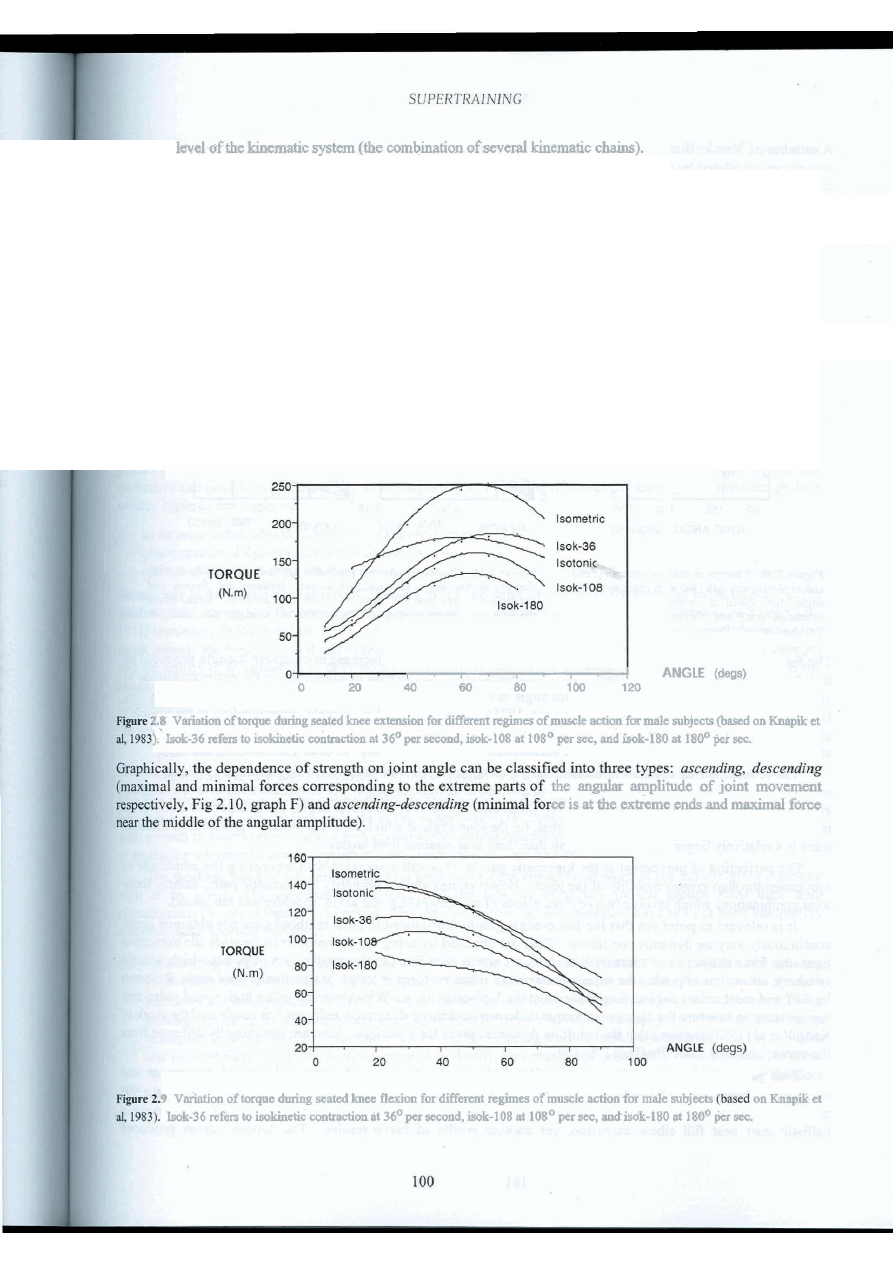
The
The K i n e m a t i c Pair
The perfecting of movement at the kinematic pair level depends on its linking purpose, development of the ability
to produce large motor force, and the execution of movement with high angular speed, or on all of these and other
factors simultaneously. The process of perfecting a movement is determined by the anatomical characteristics of
the musculoskeletal system.
Many studies indicate that, in all of the diverse isolated single-joint movements, changes in strength
apparently depend upon the role and functions of the joint mechanisms and the relative disposition of the body's
links relative to one another (Zatsiorsky, 1966; Verichoshansky, 1970). Changes in joint angle alter the conditions
of muscular work, since muscle length and angle of pull are changed. Muscular strength and leverage change, and
consequently, so does the torque (i.e. moment of force) produced by the muscles about a joint.
Thei foi , the maximum external force developed by the muscles corresponds to a specific joint angle in each
case (Figs 2.8,2.9). Thus, maximum force (measured isometrically at different joint angles) is achieved at a joint
angle of approximately 90° for elbow flexion, at 120° for elbow extension, at 60°-70° for extension at the shoulder
joint and act an angle of 60° for extension at the knee joint. Trained athletes can produce maximum force at a number
of angles close together (Kosilov, 1965; Dorofyev, 1966; Hansen & Lindhard, 1923; Wilkie, 1950).
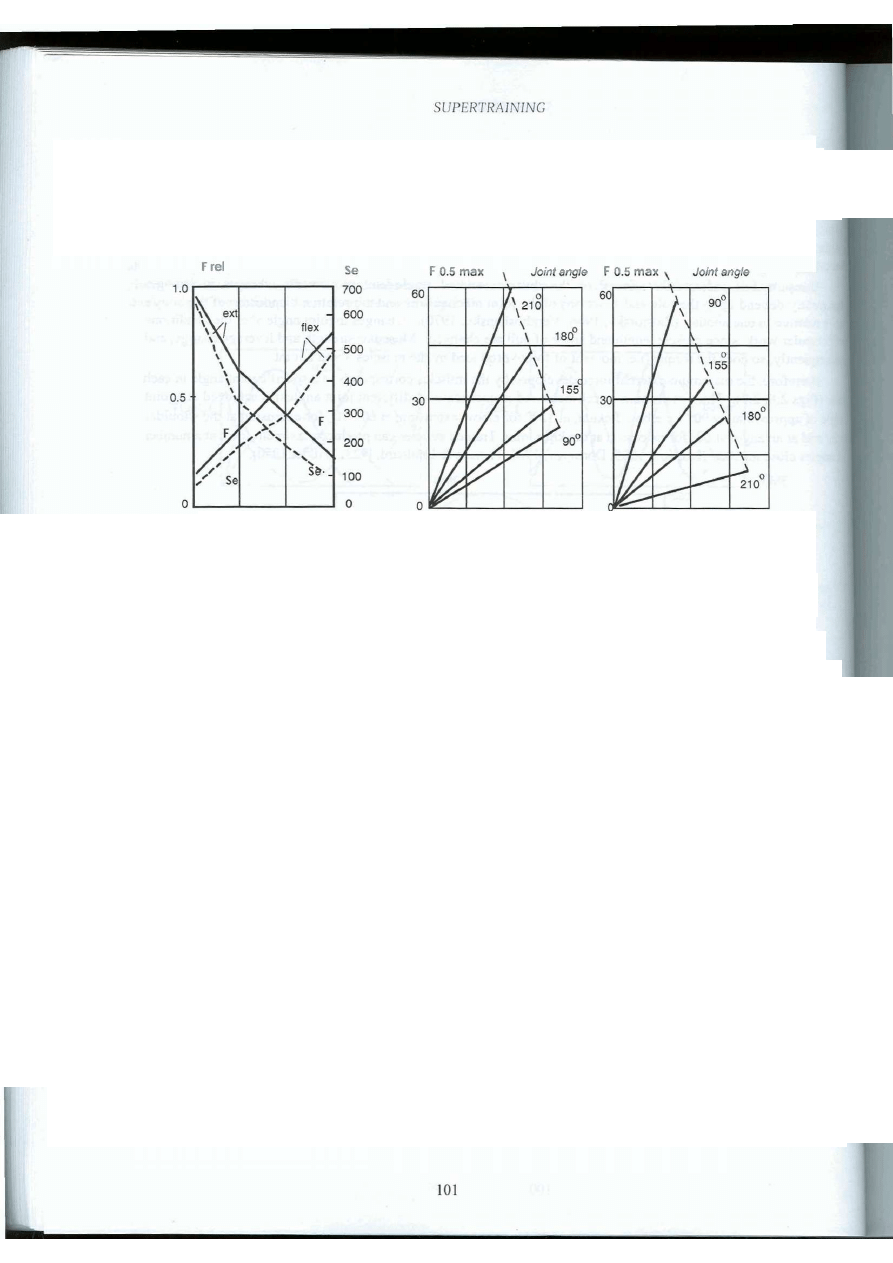
A number of Verkhoshansky's studies have established that the ability to express explosive strength (i.e.
sometimes calculated by dividing one-half the maximum isometric tension by the time taken to reach it: see 2 .1
changes unidirectionally with the change in external muscular force (Fig 2.10, graph Se). A decrease in the S( ndex
with change in joint angle is associated simultaneously with a decrease in muscular tension and an increase ii the
90 155 180 210
JOINT ANGLE (degrees)
Figure 2.10 Changes in relative strength (Frel)
and explosive strength (Se) with changes in hip
angle for qualified women sprinters for
extension (ext) and flexion (flex). (Siff &
Verkhoshansky, 1999).
FLEXION
0.08 0.16
TIME (sees)
0.08
EXTENSION
T I M E
(
s e c s
>
Figure 2.11 Change in rate of a gradually applied isometric force with
changes in hip angle for qualified women sprinters for flexion and
extension. Note that FO.Smax = 0.5 of max isometric force, which
provides an approximation of the explosive strength Se. (! if &
Verkhoshansky, 1999).
The force-angle graph does not change its form fundamentally with the increase in muscular strength produce by
training. However, a number of studies have established that the increase in strength over the entire amplitude of
single-joint movements depends on the joint angle at which maximum muscular tension is exerted during training
(Zatsiorsky & Raitsin, 1974; Raitsin & Sarsania, 1975). If it is produced at an angle corresponding to th muscle's
greatest length (i.e. the smallest degree of flexion in the joint for active muscular flexion or the least d gree of
extension for muscular extension), then the transfer of strength to the other joint angles is relatively uniform.
The reverse is true if maximum muscular force is produced when the joint is significantly flexed and the
muscles are in a shortened state; in this case the increase in strength is larger. However, the transfer of ; training
effect to other joint angles is comparatively small and, the further from this angle, the smaller the transfer of
maximum strength. It is interesting to note that, for the joint angle at which maximum force is produced in training,
there is a relatively larger increase in strength than there is at adjacent joint angles.
The perfecting of movement at the kinematic pair level is still associated with increasing the amplitude c^
movement through greater mobility of the joint. However, this applies primarily to kinematic pairs, nai sly those
joint combinations which involve two or three planes of movement (e.g. the ankle, shoulder and hip joints).
It is relevant to point out that the force-angle graphs reproduced in most textbooks are not obtained under
continuously varying dynamic conditions. They are obtained by using a dynamometer to measure th iium
isometric force at a series of successive angles. A curve is then fitted to the resulting set of points which, strictly
speaking, allows one to predict the expected maximum isometric force or torque at a particular joint angle ¡search
by Siff and mechanical engineering students at the University of the Witwatersrand using high speed video and
tensiometers to measure the changes in torque under non-isokinetic dynamic conditions has confirmed the fork of
Knapik et al (1983) showing that the resulting dynamic curves for a particular joint are significantly different from
This research also shows that the profile of the curve changes with load, velocity of movement and
orientation of the joint. For instance, the maximum torque for auxotonic elbow flexion does not occur near thi 90°
measured isometrically, but nearer full flexion. Moreover, if the myotatic stretch reflex is evoked by u ng a
ballistic start near full elbow extension, yet another profile of curve results. The torque curves produced

SUPERTRAINJNG
dynamically on isokinetic apparatus also differ radically from those measured biomechanically under unrestricted
auxotonic conditions, using free weights or pulley systems.
This does not negate the value of research done on isometric force-angle curves, which gives a fairly accurate
picture of slow movement against very large resistance. It emphasizes that there are specific force-joint angle
curves for each joint, determined by the type of muscle contraction, the velocity of movement, the starting
conditions, the load and the orientation of the joint. The phenomenon of specificity again becomes apparent.
Clearly, it is important to model the strength characteristics of each sports movement accurately to allow one to
select the appropriate training regime.
The K i n e m a t i c C h a i n
The working movements of the body are produced by a system of links in a kinematic chain where the angles in
each joint combination change simultaneously. The fundamental working functions of the kinematic chains in the
motor apparatus consist of transforming rotational joint movements to linear movement (by lengthening or
shortening the system's levers) or angular movement at the distal end of the system's links (relative to the proximal
joint).
The w ffect of the movements executed by the kinematic chain varies to a great extent, depending on
specific conditions of the system at a given time (e.g. relative disposition of the links and the motor potential of
given muscle groups). In addition, the working effect of exercises in kinematic chains is associated with larger
qualitative and quantitative changes than in kinematic pairs. Perfecting of movement through the kinematic chain is
secured by three basic factors:
• an in in the working amplitude of the movement
• concentration of dynamic force at a certain part of it
• optimal interaction among the muscles involved.
An increase in the working amplitude is achieved by a large range of motion in the joint and by an increase in the
elasticity and strength of the corresponding muscle groups and their associated connective tissues (Topolyan,
1951; Ivanitsky, 1956; Donskoi, 1960). The amplitude of movement increases in two directions of the kinematic
chain, namely the beginning and end of range. This is realised in the first case by an increase in muscular strength
and the ability of the muscles to develop a powerful force during the movement, as well as an increase in the
elastic of the functional antagonists. The force produced shows two clear characteristics over the course of a
move
1. A decrease in muscle tension at the end of the movement, especially with ballistic work (which is more
pronounced for faster movement and smaller external resistance)
2. There is an increase and a concentration of working force at a certain part of the range of the movement.
The first characteristic is an obvious protective reflex as expressed by the inhibitory action of muscle antagonists,
which is associated with the survival role of the motor system (Pierson, 1965). This mechanism does not change
with growth in sports proficiency, which concerns the second characteristic, correlating directly with the process
of producing a biomechanically appropriate movement, as discussed earlier.
The working force of a kinematic chain is produced by the coordinated work of the muscle groups serving
each of its joints. The coordination of force and the function of certain muscle groups have their own
characteristics in this context. It is noteworthy that the following two examples have not yet been adequately
analysed in the sporting literature;
(a) The resulting force is less than the sum of the forces of the muscles each kinematic pair is capable of producing
(Verkhoshansky, 1961, 1965, 1970; Yegorov, 1966). For example, in isolated elbow flexion, strength
increases as elbow joint angle decreases and reaches an isometric maximum at about 90°. However, with
isolated flexion at the shoulder, there is no significant difference in isometric strength in the 0° to 160° range
(Campney & Wehr, 1965). If the entire arm executes stretching work (simultaneous extension at the shoulder
" and forearm flexion with the working point at the hand), then maximum isometric force is produced at about
160° in the elbow joint. If propulsive work is executed by the entire upper extremity (i.e. involving shoulder
and elbow action), maximal isometric force is developed with the elbow near full flexion, i.e. near the beginning
of the push-off.
102
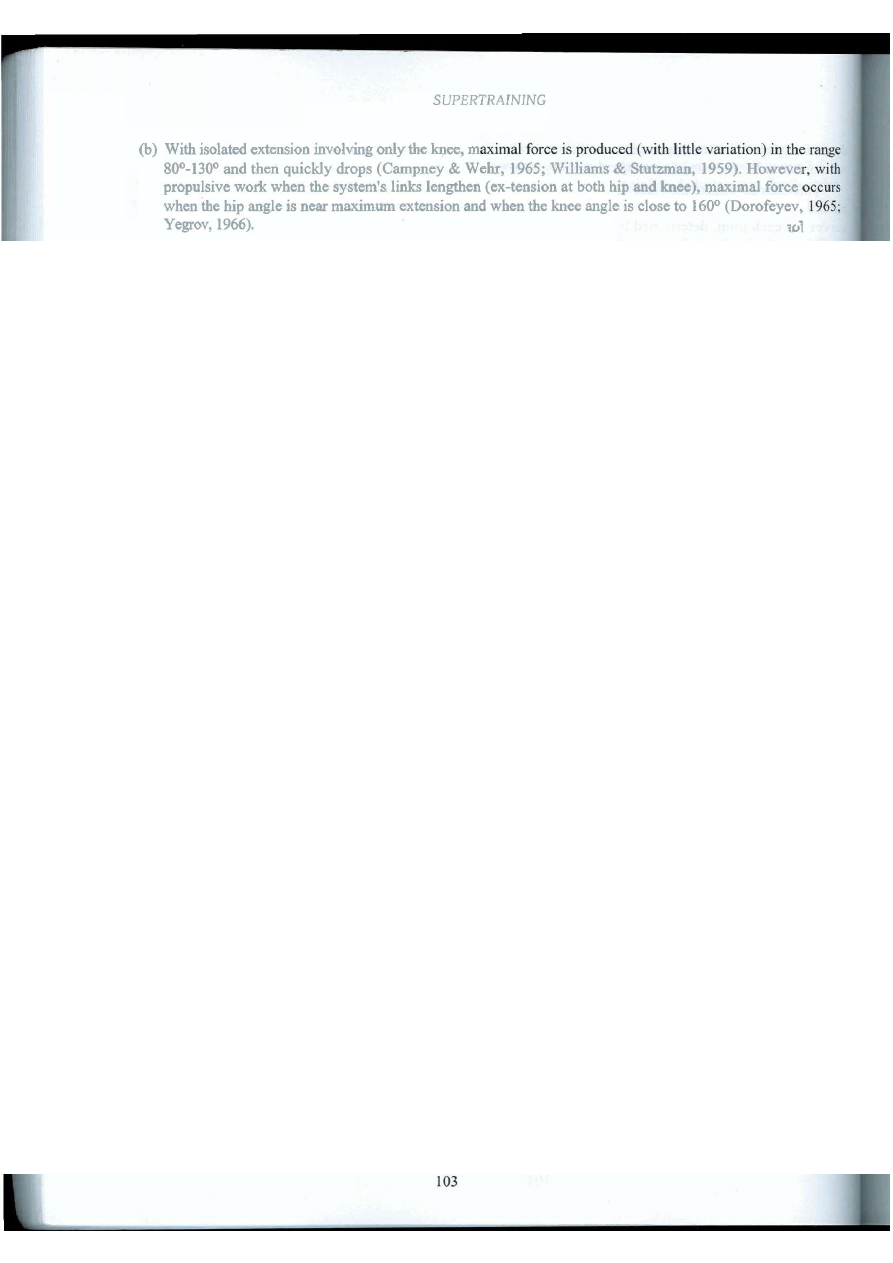
These examples illustrate the adaptation of the body to cope with bipedal ambulation. Thus, the latter example of
maximal knee extension force occurring with a nearly fully extended hip is probably associated with the dominance
Semyenov and Tatyanov (1976) have established that there is a smaller correlation between improver :nts in
running or jumping exercises and the individual maximum torque about each joint of the lower extremity, n with
the force produced by the extremity as a whole. This correlation increases noticeably with the growth in
proficiency, which indicates that efficiency of movement is determined by one's ability to optimise muscular
potential, i.e. when any functional deficiencies are strongly overcome by other physical advantages.
Careful analysis of muscle group combinations under various work conditions in the kinematic chain nables
one to identify certain biomechanical characteristics. Depending upon the activities, the athlete involuntarily
orients the links relative to. one another in the kinematic chain to ensure that the required »-force
simultaneously or sequentially uses the angles of maximal strength for each joint involved (Verkhoshansky, 1977).
The first case (a) is associated with overcoming laige external resistance, such as isometric tension (for
instance, the attempt to move a heavy object). The second case (b) is typical of movements which necessitate
imparting as large as possible a velocity to an external object or bodymass under conditions of limited working
This functional relationship between the muscle groups involved in. the kinematic chain is such that the
movement is begun by the most powerful muscles of the proximal joints fthe key muscles in the chain) and is
achieved with the support of the distal links and the joints which are rigidly fixed. The distal links then participate
in the work, while at the proximal links, fixation begins in the joints to produce a stable base for the r vements of
Thus, the athlete always strives to begin the working-force by using the joint-angle zones of maximum
strength for the specific situation. It can be assumed that sports technique evolved over many decades on precisely
this basis to ensure the most favourable conditions for exerting maximal force at the appropriate time and position.
However, in certain cases, there may be a conflict between these mechanisms and the nts of the
movement during the sports activity. This reveals in particular the need to increase the working amplitude of a
movement, especially if it is necessary to exert maximum strength in the range where this strength cannot be
produced primarily on the basis of anatomical structure.
Nevertheless, the body's high adaptive capability enables one to find the optimal solution to such conflicting
situations. This is possible, for instance, when the corresponding muscle groups (prior to beginning the working-
force) possess some additional tension accumulated during the preparatory movement phase. Thus, during the
amortisation phase (shock absorption phase) of the vertical jump, some of the elastic energy accun ited at the
end of this phase facilitates the subsequent extension of the knees.
Therefore, it is possible to begin from certain joint angles where maximal strength is produced and achieve the
greatest gain in amplitude of movement compared with jumping from an initial half-squat position (i.e. without the
amortisation phase). There is a tendency for the amplitude of amortisation during knee flexion to < ;ci ase after a
depth jump. There is an obvious effort towards operating near the angles of maximum strength in certain joints
because of the large dynamic loading encountered there. Some of the loss in amplitude of the m vement is
compensated for by the additional elastic energy stored in and released by the muscle complex. Thus, there is a
specific sequence in the process ofperfecting of movement at the level of the kinematic chain 0 xkhoshansky,
1. The choice of the optimal working amplitude of a movement based on interrelating the angles of maximum
strength for each joint, the motor potential of the muscles and the conditions facilitating resolution of the motor
task, as follows:
(a) for small external loads there is a characteristic attempt to increase the amplitude of movement
independent of the zones of maximum strength for each joint

SUPERTRAINING
(b) for large external loads where additional reserves of strength are lacking, themovement characteristically is
facilitated by decreasing its working amplitude in conjunction with an effort to execute actions near the
(c) for large external loads and additional sources of movement (e.g. force of inertia and elastic energy of the
muscles and connective tissues), there is die possibility of some increase in the working amplitude outside
the joint zones of maximum strength
(d) in all cases a forcible decrease in the amplitude of movement is compensated for by storage of elastic
energy in the muscle complex, accumulated during the preparatory phases of the movement, which ensures
a powerful initial muscular contraction.
2. An increase in the maximal motor force and its concentration primarily at the beginning of the working zone.
3. Participation of the muscles in the kinematic chain in the work in a suitable sequence which enables them to
produce powerful force and speed of contract m throughout the movement,
4. An attempt to execute the movement within the zones of maximum strength in each joint and simultaneously
enhance its efficiency by storing elastic energy during the preparatory phase.
The Kinematic System
The kinematic system possesses many linear and rotational degrees of freedom. Therefore, the process of
perfecting movement, from a level of kinematic pairs to that of a kinematic system, is closely associated with the
efficient organisation and control of the motor action. Nevertheless, biomechanical factors continue to play an
important role.
The characteristics of perfecting the movement considered earlier are associated with the sequence of muscular
actions generated in the kinematic chain and intimately involve the kinematic systein. The only difference is in the
number of functionally interacting muscle groups. This interaction involves chiefly the work of the strongest
muscle groups of the legs and torso, followed by the muscles of the shoulder girdle.
Thus, the perfecting of movement is associated with determination of the most effective method of uniting
individual kinematic chains and their working mechanisms into a single working system. The logical organisation of
such mechanisms may be referred to as the kinesiologicalpattern of a complex motor event, which is discussed
2
.1.3 Perfecting the Kinesiological P tttern of Movements
The motor programme underlying a sports exercise involves certain cause-effect relationships between its
individual elements, with their pattern of force production depending oaneuromuscular processes. In the course
of achieving sports mastery these relationships change continuously while the body searches for a more efficient
interaction between the elements of the motor complex, and its kinesiological pattern acquires further information
for enhancing this process.
This pattern constitutes the basic framework of the movement system, determining its spatio-temporal
characteristics and the functioning of the working effect. Therefore, the kinesiological pattern of a specific sport
exercise is an extremely important condition for successfully solving the problem of special strength training, -With
respect to the kinesiological pattern of a sports action, the strength field, which is a result of the athlete's
interaction with external objects, is divided into phases of voluntary action and reflexive reaction (Verkhoshansky,
1958,1963, 1966, 1968).
Note that the term kinesiological pattern is used in preference to "biomechanical pattern" or "biomechanics"
to emphasize that we are not simply referring to the action of force as an entity in physics, but as an active motor
process which involves a complex of psychological and physiological factors.
Initially these dynamic elements are expressed weakly and are irregularly distributed over the strength field
(Fig 2.12a). Not only does coordination in space and time vary widely, but the motor act as a whole is still
dynamically unstable and its final effect is inefficient and unstable. Then, as adaptation to the situation takes place,
the athlete develops the ability to more effectively manage the motor tasks. TTiis is associated with distinctions
between and increases in the dynamic accentuations, clearly localising them within tire limits of the motor complex
and unifying them into a specific, distinctly interrelated system (Fig 2.12b). Now, with repetition of a motor act,
the range of variation of its elements decreases, the process can be executed accurately over a shorter period and its
104
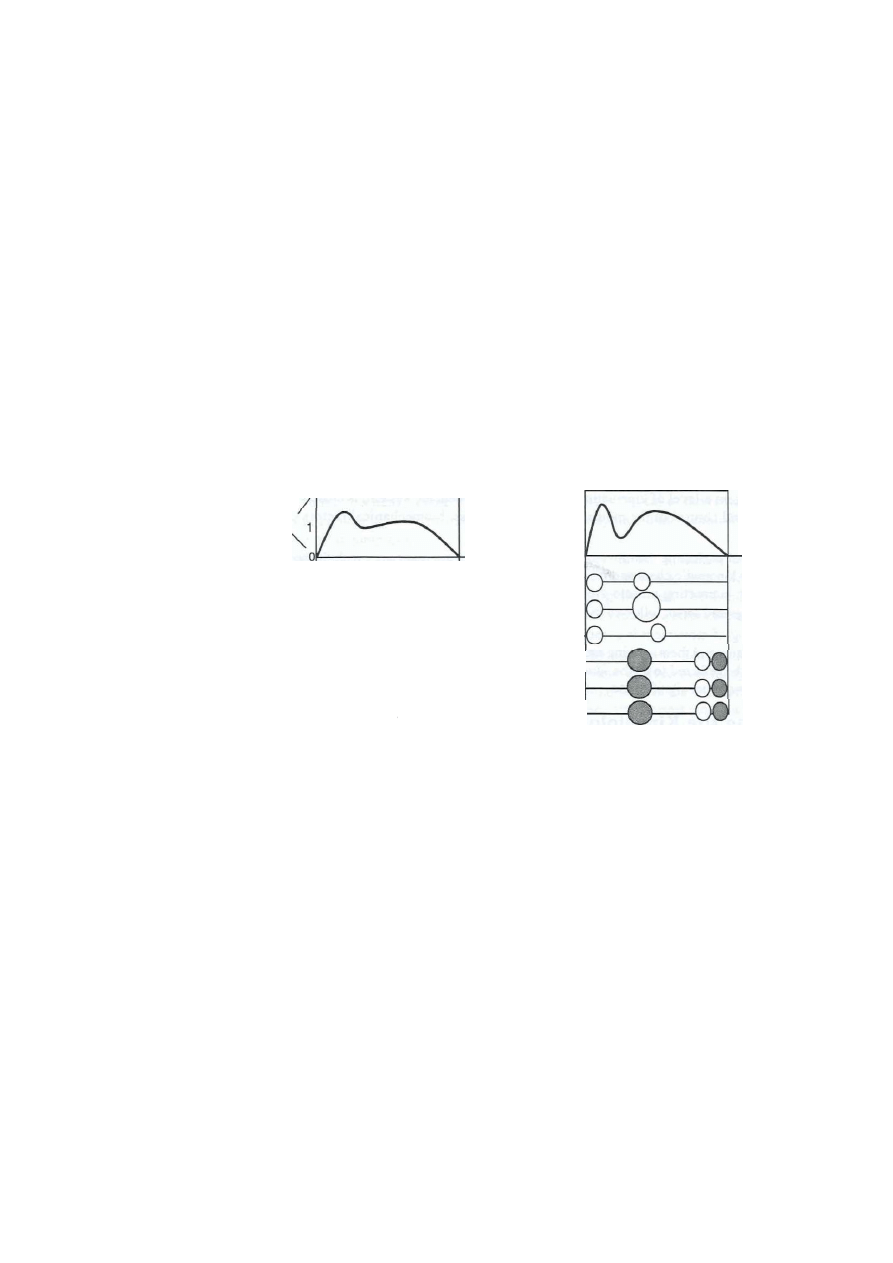
SUPEMTmiMNG
elements do not simply sum in space and time, but interact in a specific pattern of simultaneous and s [uential
actions.
The correlation between the dynamic lements is such that any change in the characteristics of one of them is
reflected in the others, even if far removed in space and time. The interrelation of elements establishes a
hierarchical scheme which involves the dominant roles of some and the subordinate roles of others. Thus, one can
separate the key elements crucial for managing the motor tasks, as well as organise the elements acting as the
fundamental components of the kinesiological pattern, and thereby increase the functional value of these key
elements (Verkhoshansky, 1977).
Thus, the kinesiological pattern of a motor action enables an athlete to effectively use his motor potential to
execute specific physical tasks. As the motor system becomes an integrated whole, it reacts and functionally
evolves as a whole. When a kinesiological pattern is firmly established, a motor act is reproduced at a new, higher
level of efficiency, increasing its working effect by optimal use of the body's motor potential.
As has already been discussed, the kinesiological pattern is constantly perfected by refining the connections
between the elements of the motor complex. However, the motor complex possesses a certain lexibiaty in
specific situations and an ability to e<ipe with strong eternal influences without disrupting its functional
effectiveness, l i d s becomes possible because of the kinesiological pattern's ability to adapt to externa events.
( a ) Beginners
F O R C E
/
2
\
\
0 — O -
0 — o -
O -
• o — a
0 — © —
^^^ ^^^
0.144 s e c
( b ) Q u a l i f i e d Athletes
FORCE
Hip joint
Knee joint
Ankle joint
Right arm ( 3
Left arm Q
Rot Leg Q
0.120 s e c
F i g u r e 2.12 Sequence of accentuated active and reactive d y n a m i c s of the motor system for the second t a k e - o f f in a triple jump: 1.
resulting force-time curve; 2. accentuation in the tension of the relevant muscles of the hip, knee and ankle joints of the support leg
(measured with a myotensiometer); 3. accentuation of active and reactive (shaded circles) dynamics of rotary movement associated with
the swinging arms and leg. a = beginners and b = qualified athletes. The open circles refer to active, concentrated voluntary effort. (Siff
& Verkhoshansky, 1999).
It should be pointed out that the principle of dynamic organisation applies to any complex motor act. However,
acyclic exercises demand the production of significant force over a minimal time, so that the concept of training
consists of forming and perfecting the kinesiological pattern. On the other hand, cyclic exercises require the
prolonged maintenance of work output. In this case, the kinesiological pattern develops significantly more
rapidly, its composition is simpler and the concept of training consists primarily of perfecting the contributions of
the involuntary functions of the body.
The kinesiological pattern is part of the general strength field, i.e. the sum of all the external and internal forces
involving the body while it undertakes a given-motor task. The force producing movement is the geometr c sum of
external, internal and reactive strengths. If this classification is based upon the character, origin and < rection of
force, the components of the strength field may be recognised as follows (Verkhoshansky, 1977):
1. The active driving force produced by muscular contraction.
2. The reactive force, which arises as a result of the interaction of the active muscles with the environment. '
3. The force stored in the muscle complex as elastic energy during the preparatory phases of a movement.
4. The force of inertia of the body or its links.
5. The weight of the body or its links.
105

S UPERTRAINING
Each of these factors is involved in the process of solving motor tasks and has a distinct influence on the results.
Therefore, each must be considered when one is analysing the kinesiological pattern of the movement system and
selecting the special strength-training means. These forces, depending upon the place and point of application, can
be external or internal to the body; and depending upon the direction of movement of the body, they may assist or
resist movement. It is necessary to identify further characteristics of the strength field. Relative to the body, the
strength field consists of two systems (Verkhoshansky, 1977):
• the external interaction with the motor apparatus
• the internal interaction with the motor apparatus.
These systems appear simultaneously and in several aspects act independently of each other, but they obviously
influence each other:, to an extent which increases as sports proficiency improves. The composition of the system
of external interaction decisively influences the structure of the internal strength system, whereas the internal
interaction system depends on the magnitude and direction of the resulting movement and its change over time.
Hence, the kinesiological pattern of a sports action can be the appropriate concept only if it represents part of
the general strength field. At the same time, control of the external interaction of the motor apparatus is possible
only through the internal kinesiological pattern. Consequently, when referring to control of the athlete's
movements, one must consider not so much the movement (i.e. the relative shifting of the body's links), as the
kinesiological pattern and its influence on die working-effect of the movement. This forms the pedagogical basis of
the problem of contro nj luman movement.
12.2 Specialisation to Develop Sports Mastery
One of the main features of the sports training process (STP) is the steady perfecting of the athlete's physical
system, which occurs with a certain regularity. In the beginning, the body reacts fairly gen lly to any new motor
regime with all of its systems and this is sufficient for the initial sporting successes However, subsequent
adaptation tends to be more selective, conditioned by the motor specifics and the pecu arities of the external
factors. Under such conditions, one of the body's systems may receive considerable develc, whereas another
may receive less, depending upon their respective roles in meeting the requirements of the motor activity.
Adaptation has been examined in sufficient detail in various texts on the anatomy, physiology, medicine,
biomechanics and biochemistry of sport. However, the character and tempo of the adaptations and their
interrelation in the STP have not yet been studied adequately. This is an important problem in applied exercise
science and constitutes the scientific foundation for any theories of sports training. Some characteristics of
adaptation of the athlete's motor apparatus during long-term preparation to develop strength are discussed below.
2.2.1 Specific Forms of Producing Muscular Strength
Depending upon the primary coordination pattern of the motor activity, muscular strength acquires a specificity
which becomes more apparent as one's level of sports mastery grows. Some of the fundamental specific forms in
which strength is displayed in athletic activities are: absolute strength, explosive strength and strength-endurance.
Maximum strength characterizes the athlete's strength potential and is a measure of the maximal voluntary
isometric muscular force which can be produced without a time limit or a limit to the amount of weight lifted. The
term absolute strength is often regarded in other books as synonymous with maximal strength, but this text
confines it to mean maximum involuntary strength (seeCh 1).
The relative strength of an athlete (i.e. amount of force produced per kilogram of bodymass or sports
apparatus) is also defined in sport. This index is sometimes used for comparing the strength of athletes of
different bodymass, although it is scientifically preferable to reserve its use for assessing changes in an individual
with time. Comparison of the strength of individuals of different bodymass is far more accurate by applying the
adjustment equations detailed in the next chapter (see 3.3.5).
Speed-strength characterizes the ability to quickly execute an unloaded movement or a movement against a
relatively small external resistance. Speed-strength is assessed in terms of the speed of the movement.
Explosive strength characterizes the ability to produce maximal force in a minimal time. The index of
explosive strength IES is often described roughly by dividing the maximum force by the time tmax taken to produce
this level of force (Fig 2.13a), thus (Zatsiorsky, 1995):
IES = F
m a
x / tmax (Newtons per second)
106
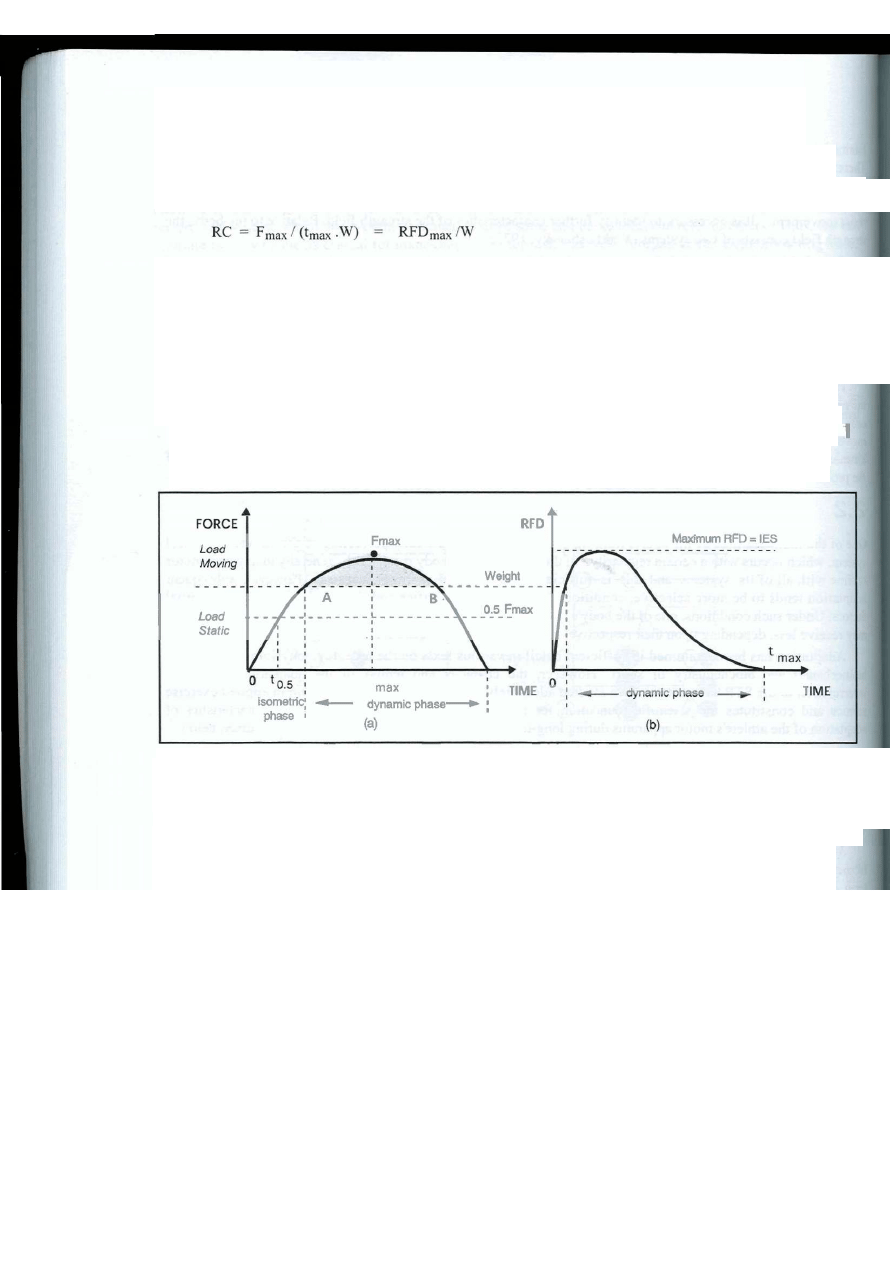
SUPERTRAINING
although mathematically, it is given by the maximum value of the slope of the force-time curve.
Explosive force production is also described by another index called the Reactivity Coefficient, RC, whicl s the
explosive strength index relative to body weight or the weight of the object being moved (see 3.2.1):
The most accurate way of assessing force development at any instant is to plot the slope (tan 6) of the force-time
graph versus time or to use a computer to simultaneously display the curves of force versus time and the s pe of
the F-t curve (i.e. the Rate of Force Development) versus time. The maximum of this Rate of Force Dev tent
(RFD) curve gives a precise measure of explosive strength (Fig 2.13b). In addition it may be noted that th sn aller
the value of t
m
ax > the more explosive the movement. Analysis of the F(t) curve of explosive force reveals three
further characteristics of the movement, namely (Verkhoshansky, 1966,1970,1972): ,
* The maximum strength of the muscles involved (Fmax)
• The starting-strength, or ability of the muscles to develop force at the beginning of the workin{ l
The acceleration-strength, or ability over time to quickly achieve maximal external force while developing
muscle tension isometrically or at the beginning of a dynamic contraction.
Figure 2.13 (a) Force-time curve illustrating a method for determining explosive, starting and acceleration strength, W is thi ("eight
being overcome by the force F(t). Movement occurs only when the force exceeds the weight W of the object,
(b) Rat force
development (RFD) curve up to tmax obtained by plotting the slope of the force-time graph versus time. The maximum rate enforce
The following formula is used to calculate an index of starting-strength ISS (or the S-gradient), which i bited
during the contraction just preceding the movement of the load (Zatsiorsky, 1995):
ISS = 0.5 Fmax / to
.5 where to.5 is the time taken to reach one half F
m
ax
The index of acceleration strength IAS (or the A-gradient), usually used to quantify the rate of force de\ lopment
(RFD) during the late stages of developing muscular force, is described by the formula:
IAS = 0.5 F
m a x
/ (t
m a x
- to
.5)
Explosive strength is most commonly displayed in athletic movements when the contraction of the working
muscles in the fundamental phases of die exercise is preceded by mechanical stretching. In this instance, th< switch
from stretching to active contraction uses the elastic energy of the stretch to increase the power of the si uent
contraction. This specific quality of muscle will subsequently (3.2.1) be called its reactive ability (RA). 1
Strength-endurance characterizes the ability to effectively maintain muscular functioning under Ark
conditions of long duration. In sport this refers to the ability to produce a certain minimum force for a proloE :ed
period. There are different types of muscle functioning associated with this ability, such as holding a g^ern
position or posture (static strength-endurance), maintaining cyclic work of various intensities (dynamic stretch-
endurance) or repetitively executing explosive effort (explosive strength-endurance). ' 1
107
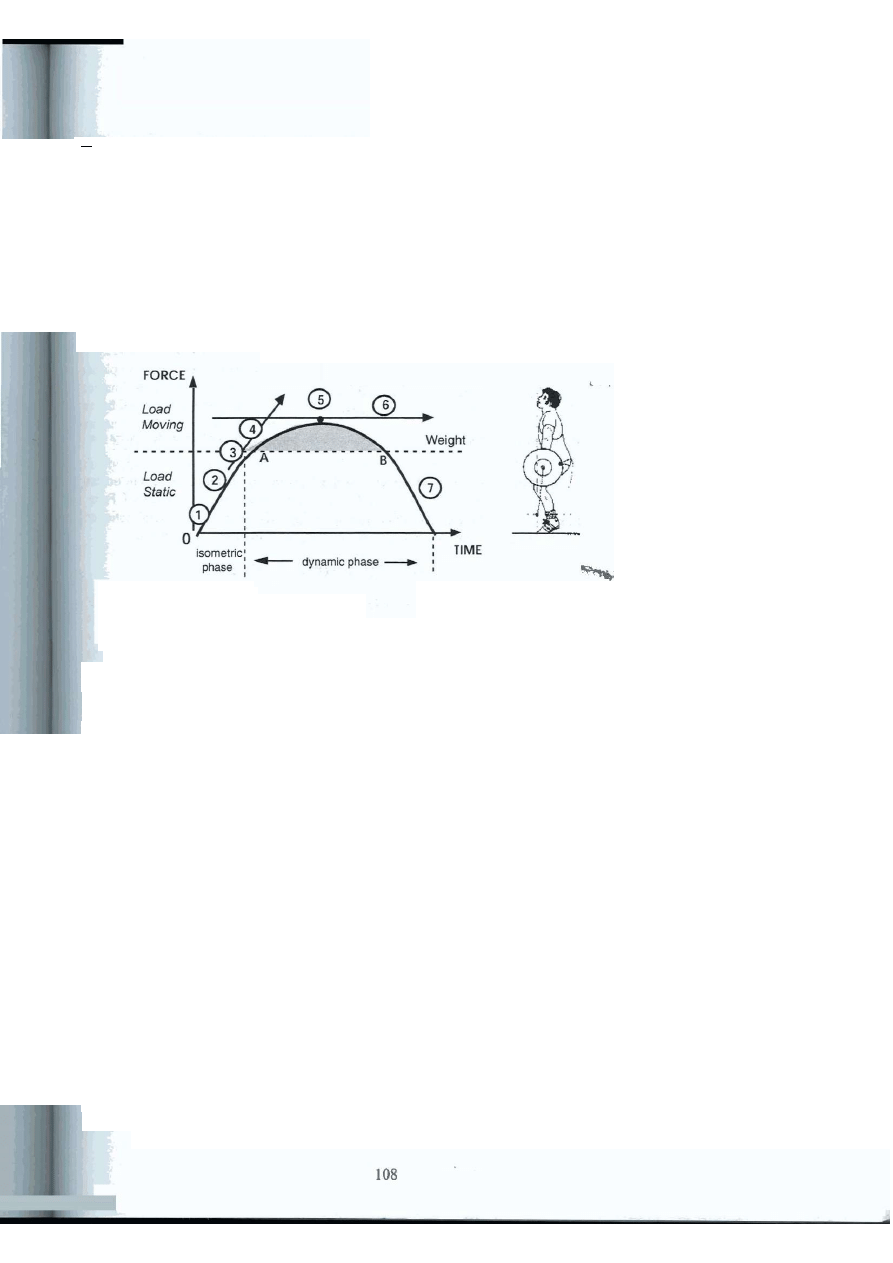
SUPERTRAINING
2.2.2 ^Sports Impttcatfcms t)i Strength imftccs
To progress beyond these dynamometric analyses of strength and to better understand the role of strength in sport,
it is relevant to commence with an analysis of a typical force-time curve in lifting a free weight from a given position
Starting-strength, as introduced earlier, refers to the ability to build up working force as rapidly as possible
once muscle contraction has begun and it is always produced under conditions of isometric muscle action. This fact
alone lias important consequences for strength training, because it dispels the opinion that the once-popular method
of isometric training should be completely abandoned in modern training. On the contrary, the ability to generate
starting strength rapidly can exert a profound effect on the dynamics of an entire movement, not only in terms of
the magnitude of the impulse, but also regarding the psychological sensation of "lightness" that it creates during the
crucial initial stage of a highly resisted movement.
Starting Strength
Acceleration-Strength
Rate of Force Development (RFD)
Explosive Strength (Maximum RFD)
5. Maximum Strength
6. Strength-Endurance
7. Deceleration Strength
Figure 2
.14 A typical force-time curve describing the lifting of a free weight from a given position and returning it to it to rest.
Movement occurs only when the force exceeds the weight of the object, namely over the shaded portion of the curve.
If the load is near maximal, then the initial slope of the Force-Time curve is small and the time taken to produce
movement is prolonged. This requires the exhibition of the motor quality of static strength-endurance, as opposed
to dynamic strength-endurance, which refers to the muscle endurance required to maintain movement over a given
interval. This quality may be involved in carrying out a set of repetitions with a load or by maintaining cyclic work
of various intensities One may also identify a property known as explosive strength-endurance which involves the
repetitive execution of explosive effort. As we learned above, acceleration-strength describes the ability of the
muscle to build up force as rapidly as possible under dynamic conditions once the contraction has already begun:
Finally, we recall that explosive strength is the ability to produce maximal force in a minimal time. It is most
commonly displayed in athletic movements when the contraction of the working muscles in the fundamental phases
of the exercise is preceded by mechanical stretching. In this instance, the switch from stretching to active contraction
uses the elastic energy of the stretch to increase the power of the subsequent contraction, a process that is central to
the so-called stretch-shortening cycle and 'plyometric' or rapid rebound action. This specific quality of muscle is
called its reactive ability.
Suppose that we now wish to use the information from Figure 2.14 to compare the performances of two
different athletes in executing the same exercise. They have both been instructed to perform a single maximal
repetition of this exercise as rapidly as possible and to hold the load for as long as possible until fatigue forces them
to stop. Their resulting force-time curves (Fig 2.15) show that athlete B exerts a greater maximal force and
continues to produce force for longer than athlete A. However, at any instant Ti between 0 and time T2, athlete A
is able to exert greater force than athlete B. If the sport concerned requires rapid RFD (Rate of Force
Development), then athlete A will have the advantage.
This quality is essential in any sports which involve jumping, striking or throwing, such as basketball, martial
arts and track-and-field. In this case, any training aimed at increasing B's maximal strength or bulk will be
misdirected, because he needs to concentrate on explosive strength (RFD) training. If the sport requires a high
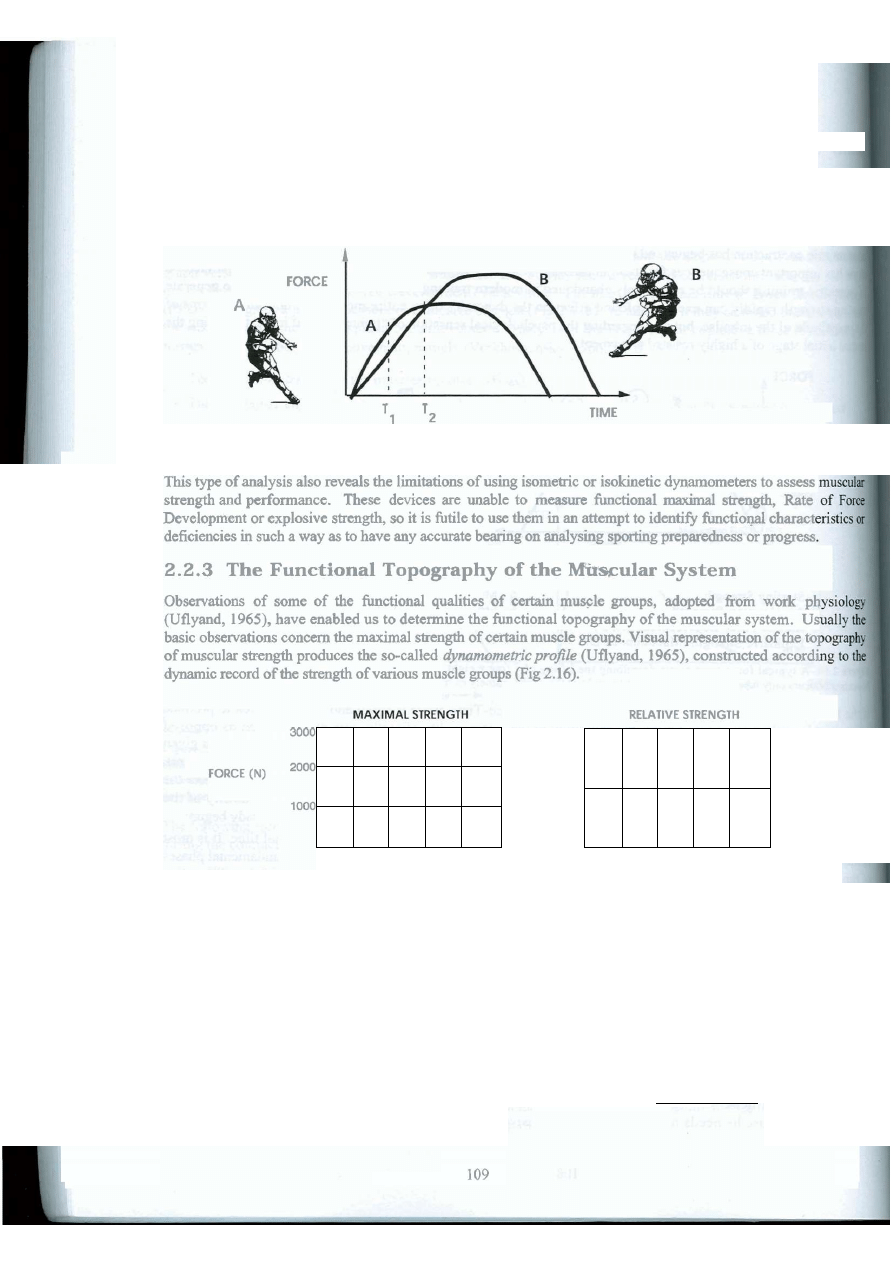
SUPERTRAINING
maximal force or a large amount of momentum to be exerted irrespective of time, then athlete B wil jrove to be
superior. Athlete A will not improve unless he trains to increase maximal strength.
The area under the curve (i.e. momentum) which describes athlete B's performance is greater than the
corresponding area for athlete A, like the total duration of his curve (i.e. reflecting muscle endurance), so that B has
a distinct advantage in any activity that requires great momentum or great muscle endurance during a single hea-
effort. This situation occurs in events like wrestling, powerlifting, rugby scrumming and judo.
Figure 2.15 Force curves produced by two different athletes in attempting to produce optimal motor output or force-time patterns in a
y
/
*
r
•
\ \
\ \
\ \
\ \
\ \
//
/ /
•
\
\
\
/ B
•
\
/
•
t
F / W
1
\
\
s. %
\ \
//
/ /
/ »
s.
A
X
\
V
x /
' +
/
/
+
>
ft
//
\
>' B
2 3 4
JOINT ACTIONS
2 3 4
JOINT ACTIONS
Figure 2.16 Dynamometric profile for high jump
( A )
and distance running
(B), giving different joint actions: trunk extension
(1), trunk
flexion
(2),
thigh extension
( 3 ) ,
ankle plantarflexion
( 4 )
and ankle dorsiflexion
(5).
Force is in Newtons and relative strength is
the ratio
The dynamometric profile enables one to compare the strength fitness of individual athletes. Of particular interest
is the study of the general dynamometric profile which characterizes the strength topography of representative
muscle groups of athletes of different specialisation, as well as the changes in the general profile with growth of
sports mastery. Such a general profile reflects the characteristics of the strength fitness of athletes in a given sport
and can serve to some extent as a standard for controlling the training process.
Semyenov et al (1971) showed that the general dynamometric profile of athletes of one specialisation is I
preserved as sports mastery increases (Fig 2.17). However, there is always some irregularity in the rati of
strength development of certain muscle groups at no ind higher training _ characteristi of
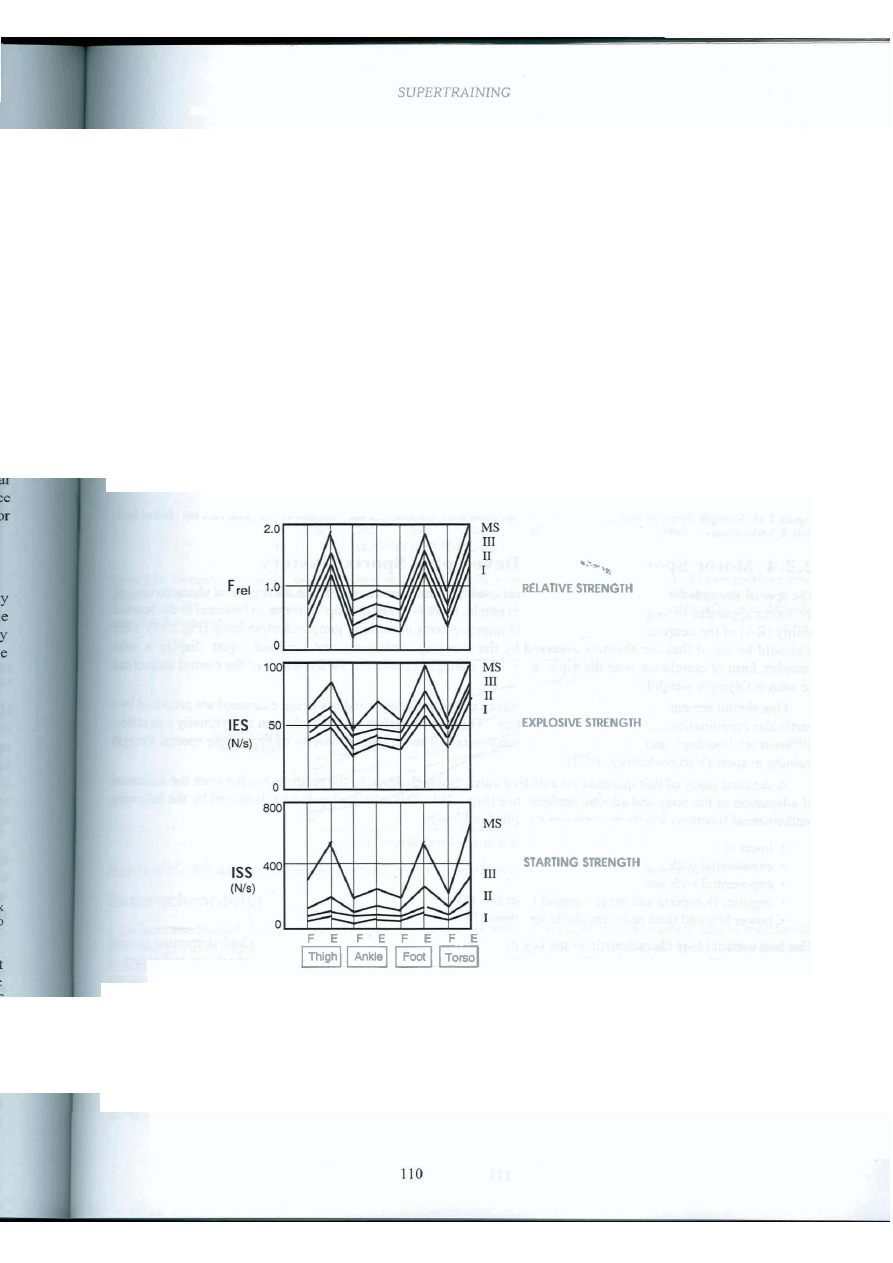
sporting development and is associated with the changing conditions of the athlete's interaction with external
objects, which decrees hat some muscle groups display a large potential for development, and others, less.
Thus, the dynamo) ; profile clearly expresses the specialised character of the perfecting of the motor
action of a competitor in a particular sport (Verkhoshansky, 1977).. However, muscular strength is only one of
the characteristics of the functional specialisation of the motor apparatus. People with identical dynamometric
profiles demonstrate different sports results. The cause of this is the different levels of development of indicators
such as the ability to rapidly produce external farce from the commencement of muscular tension.
For instance, two WOmen sprinters may be roughly equal in relative strength (Fig 2.18). However, one of
them runs the 100m in 12.1 seconds and the other in 12.4 seconds. The reason for this is the differences in the
speed qualities of the muscles as characte by their ability to quickly develop maximum working force (the
ratio of maximal strength to the time of its display for explosive-isometric muscular tension).
From this it is obvious that the characteristics reflecting the topography of the athlete's muscular system
should include its diversity, nd those qualities of muscle essential to the given sport. This enables one to obtain a
comprehensive idea of what may be termed the junctional profile (sometimes called the polyfunctioned profile) of
the athlete's muscular syst which has important significance for determining the objectives of his special
preparation (Verkhoshansky, 1977).
Figure 2.1" depicts a portion of such a Junctional profile of women sprinters of different qualification, giving
chiefly the speed-strength haracteristics. The basic differences in the women's speed-strength with increase in the
level of mastery may easily be seen in the lower two graphs, in particular the last one.
Figure 2 General functional profile of muscular systems of women sprinters. The labels I, II, HI, and MS refer to Class III, Class n,
Class I a Vlaster of Sport, respectively. F and E refer to flexion and extension, respectively. Frel = relative strength. (Siff &
Verkhoshansky, 1999).
The functional profiles clearly indicate that the specific adaptation of the motor apparatus involves chiefly those
of its segments with which the sports performance is primarily achieved. The nature of such adaptation reflects
the specific characteristics of the work regime and, with the growth of mastery, this is displayed even more
strongly. Thus, the junctional profile of the muscular system is a prerequisite for formalising the objectives of

JF E F E F E F E
Thigh Ankle| | Foot | | Torso
Figure 2.18 Strength fitness of two 100 metre woman sprinters with times of 12.1 sec (continuous line) and 12.4 sec (dashed line).
2.2.4 Motor Specialisation in Developing Sports.Mastery
The special strength fitness of athletes of different qualification gives an idea of the most general characteristics of
the motor apparatus in long-term training. For example, there is a relationship between an increase in 1 e reactive
ability (RA) of the neuromuscular apparatus and improvements in the long jump and triple jump (Fig 2.19). Here
it should be noted that the abilities assessed by the standing triple jump and the back squat displ y a more
complex form of correlation with the triple jump. An analogous pattern in the dynamics of the control indices can
One should remember, however, that in the given case, the dynamic indices being examined are produced by a
particular combination of specific motor abilities. The rate of perfecting each of them individually can reflect
different relationships, an understanding of which is vital for solving the problems of organising spec 1 strength
A detailed study of this question reveals five variants which describe the relationship between th< indicators
of adaptation of the body and athletic performance (Fig 2.20). This relationship can be described by th following
mathematical functions which are commonly applied in biology:
• exponential with slowed growth (2)
• exponential with accelerated growth (3)
• logistic, Gompertz and other sigmoid functions (4)
• power law and third order parabolic functions (5).
The first variant (1) is characteristic of the key motor abilities, i.e. the dominant abilities which e success
in the sport. The second variant (2) is characteristic of those non-key motor abilities which are indicators of
general physical fitness. They play an important role in the initial stages of the sports training process to secure
conditions for the harmonious development of the body and to provide a foundation for perfecting spec: fic motor
abilities. The third variant (3) is characteristic of the specific adaptation which determines chiefly the
developmental level of the key motor abilities, and consequently the success of the athletic achie nents as a
whole. The form of this relationship indicates that the growth of sports performance requires th :celerated
development of the key motor abilities. The correlation of the latter with athletic results increases s: nificantly
with the growth of sports mastery. The fourth (4) and fifth variants (5) are characteristic of th< /ariety of
dynamic non-essential and key motor abilities in the sports training process.

S UPERTRAINING
LONG
JUMP
Cm)
7.5
2.1 -
6.8
2.1 -
1.9 -
6.1
1.7 .
RELATIVE
SQUAT 1.5 -
1 3
RA
LJ
STJ
Squat^.
Squat^.
LOAD
(kg)
230
170
90
8 0 -
70 -
VERTICAL
JUMP
(cm)
6 0
- 3 2
- 9.4
•26
- 9 . 1
- 2 0
- 8 . 7
REACTIVE
ABILITY
(a)
STANDING
TRIPLE JUMP
(m>
13 14 15 - 16
TRIPLE JUMP (m)
17
squat
C & J
P J ^
110
POMMEL JUMP
(cm)
(b)
150 250 350 450
WEIGHTLIFTING TOTAL (kg)
550
Figure 2.19 D y n a m i c s of control exercises relative to the sports results of triple j u m p e r s and weightlifters. T h e weightlifting data
applies to the period up to 1971 when competition comprised the triathlon, i.e. the press, snatch and clean-and-jerk (C & J). RA =
reactive ability, STJ = standing triple j u m p , PJ = j u m p onto a pommel horse, VJ = standing vertical j u m p , and squat refers to the back
squat. (Siff & Verkhoshansky, 1999).
FUNCTIONAL
INDICATOR
RISE IN PERFORMANCE (OVERTIME)
Figure 2.20 The different types of relationship between physical adaptation and performance. (Siff & Verkhoshansky, 1999).
Heterochronicity
It has been established that, as sports proficiency grows, a key ability for achieving a movement can be transferred
from one group of muscles to another. Specific regularities in die process of functional specialisation of key
muscle groups are observed particularly in what may be called the heterochronicity of the rate of developing
specific motor abilities (Verkhoshansky, 1977). In the absence of a term existing to describe the phenomenon, this
word was coined to describe the process in which spécifié events do not occur simultaneously or asynchronously,
butin a complex sequence of distinct steps or actions, each of which lays the foundation for the next one.
Thus, Nikonov and Verkhoshansky found an irregular strength development of certain muscle groups of pole
vàulters. If the strength curves are compared (Fig 2 .21a), as well as the derivatives (with respect to height) which
describe thé rate of strength increase relative to athletic achievements (Fig 2.2 lb), then it is easy to notice that die
shoulder flexors ( 1 ) prolong the functional perfecting begun by the abdominal muscles from the moment when the
strength of die latter begins stabilisation.
112
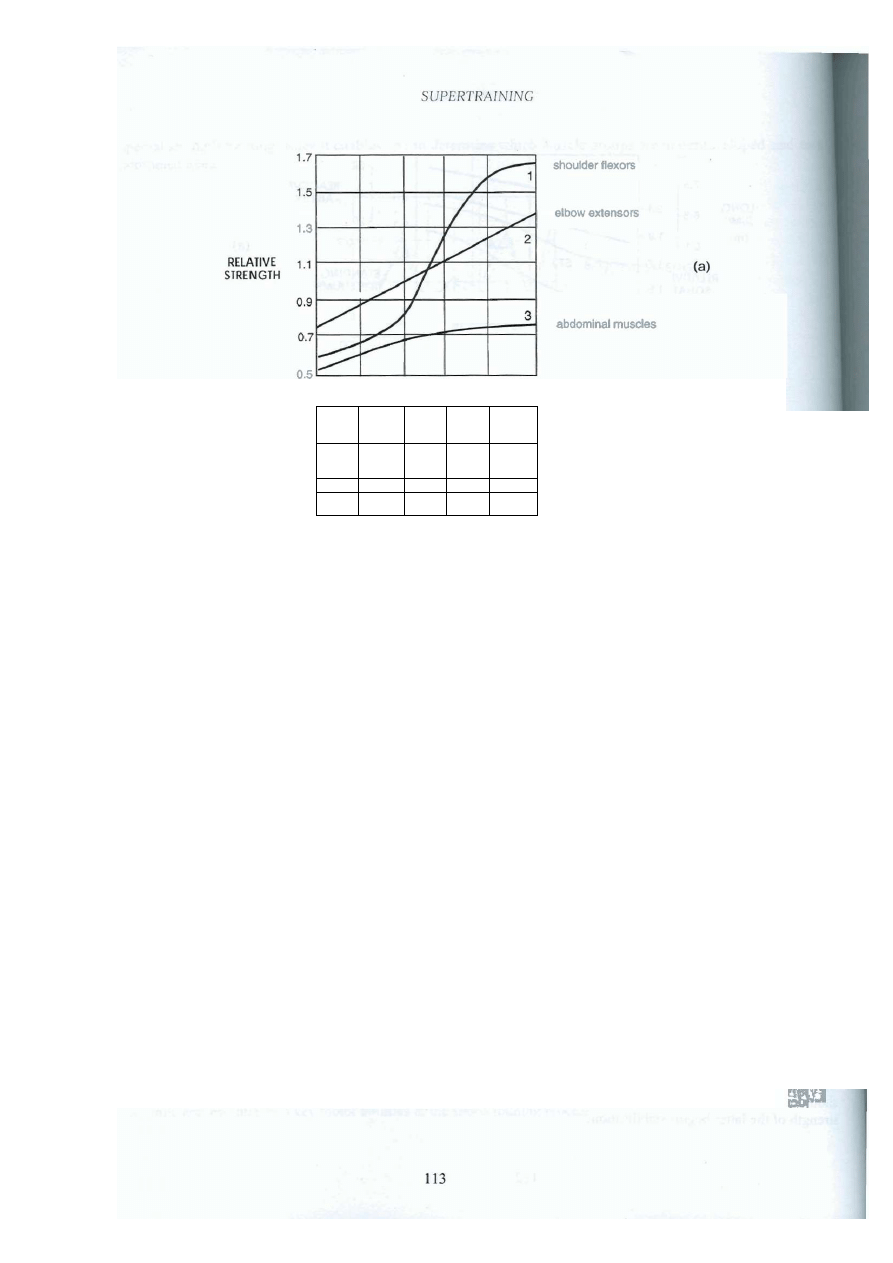
3.2 3.6 4.0 4.4 4.8 5.2 HEIGHT (of vault) in metres
1.5
RATE OF 1.0
RELATIVE
STRENGTH
INCREASE 0.5
1
3
(b)
3.2 3.6 4.0 4.4 4.8 5.2 HEIGHT (of vault) in metres
2.21 . Increase in relative g >f the shoulder flexors (1), elbow extensors (2) and the abdominal muscle ( ) o _>ole-
vaulters with growth of sports mastery, (b) Increase in rate of change of relative strength relative to height achieved, for the same muscle
groups of pole-vaulters. (Siff & Verkhoshansky, 1999).
This continuity is easily explained. Novice athletes raise their bodies up the pole with their abdominal muscles,
but with increase in mastery, this raising is executed quickly by the arms and shoulders. The strength of these
muscles increases significantly at the same time as the strength of the elbow extensors (2) increases uniformly^
In a study conducted by Verkhoshansky and Purvin, it was discovered that, with the growth oi in the
shot put, the key roie gradually shifts from the shoulder to the leg muscles (Verkhoshansky, 1977). For beginners,
the correlation between athletic achievements and the strength of the arm muscles is 0.83, and with leg strength
0.37. The corresponding figures for highly qualified athletes are 0.73 and 0.87, respectively.
A more detailed analysis of the functional specialisation of the key muscle groups (in the example of jumpers
and sprinters) also reveals the heterochronicity phenomenon. It appears in the given case in two forms:
• the non-coincidence of the initial rate of increase of specific strength factors (Fig 2.22a)
• the characteristic sequence of functional specialisation in the key muscle groups (Fig 2.22b).
Thus, maximum strength and absolute strength (So) increase from the beginning of training, then explosive strength
(Se) begins to increase and only later does starting strength (Ss) rise significantly. It should, however, be noted that
approximately linear increase in maximum and absolute strength is typical only of those sports where th< e
overcomes relatively small resistance, and where the speed of producing working force and not the magnitude if
the external force is most important. In the higher stages of sports mastery, there is typically some slowing o e
rate of strength increase.
The second form of heterochronicity appears in the non-coincidence of the initial acceleration of growth in the
key muscle groups of specific abilities such as starting-strength (Fig 2.22b). They are revealed first at ankle flexion,
then thigh extension and finally, thigh flexion.
It is easy to trace the connection between the above-mentioned forms of heterochronicity in perfecting he
action of certain muscle groups, by examining the changes in the work capacity of the motor system in lonj n
training. The commencement of training produces an immediate increase in absolute strength. Explosive :h
then begins to increase with the introduction of speed-strength training. Finally, the increase in speck h
training within the general volume of means (including the execution of the fundamental sport exercises with an
intensify close to competition intensity) leads to a quick increase in starting-strength.
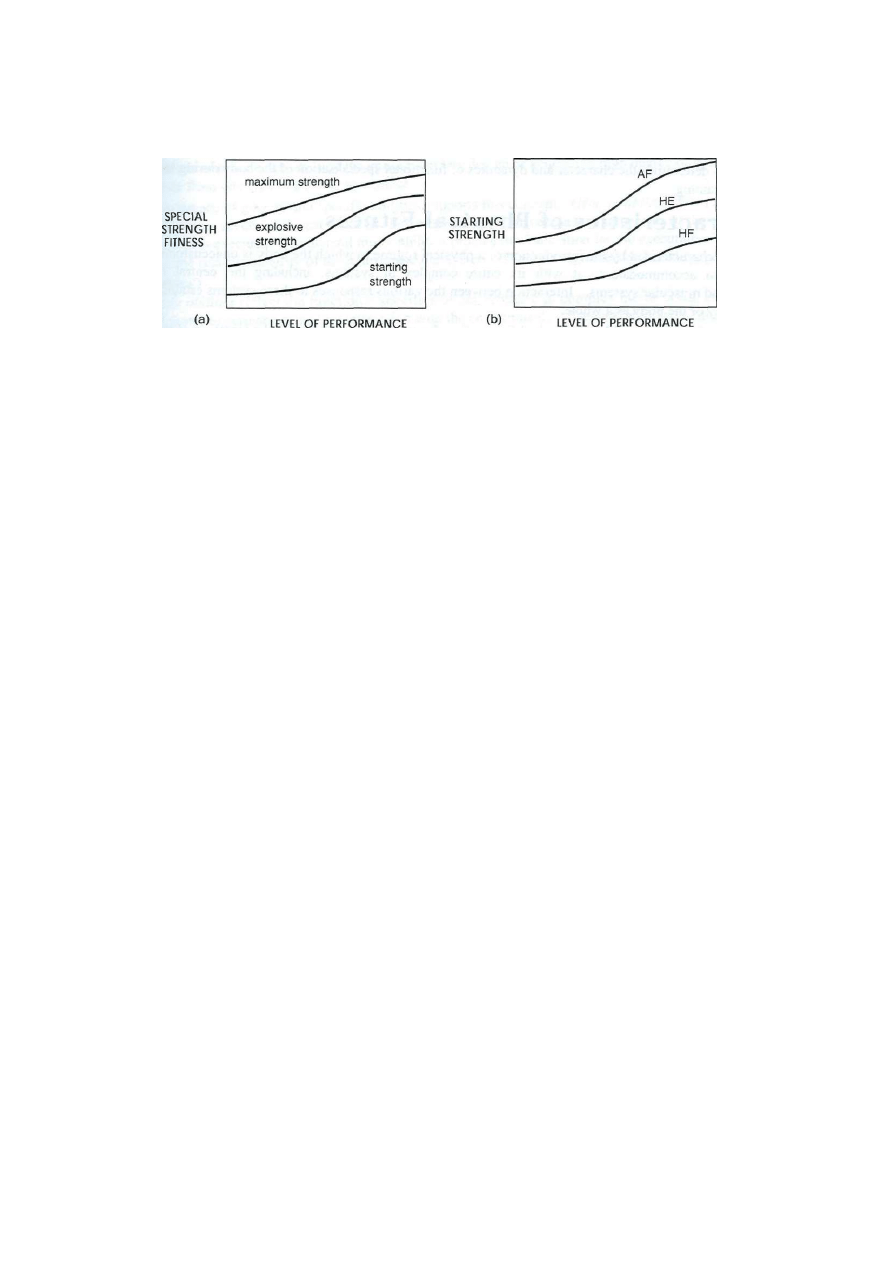
S UPERTRAINING
Figure 2.22 Dynamics of speed-strength (a) and starting strength (b) relative to sporting results. AF = ankle flexion, HE = hip
extension, HF = hip flexion. (Siff & Verkhoshansky, 1999).
The heterochronicity phenomenon in the process of functional specialisation of the support apparatus depends
first on the differing rates of development of starting-strength in certain muscle groups. Later it involves other
factors. For example, the flexors of the joints of the feet are subjected to the most intense loads at the onset of
training. Therefore, specific functional improvement is discovered in them first, as expressed by the increase in the
starting strength of the ankle flexors (Fig 2.22b). Then, as the extensor force (for pushing off) increases,
adaptation in the hip and knee joint extensors begins to intensify.
These muscles act to oppose the force of gravity and the inertia of the body's mass obviously requires them to
produce significant tension. On the other hand, the flexors of the hip have to overcome only the force of gravity
and the inertial resistance of the mass of only one leg. Consequently, they require less emphasis on functional
perfecting. Therefore, the hip flexors are significantly weaker and display motive force more slowly than the hip
extensors. In addition, their starting-strength increases later, but is distinguished by a less intense increase.
Specialisation Processes
We should turn our attention to the fact that the starting-strength and explosive strength (see 2.2.1) increase
slowly in the advanced sports mastery stage (Fig 2.22). As was shown previously, this is associated with a
decrease in the effectiveness of the means of special strength training, which appears to be one of the reasons for
the decrease in the growth of sporting performance. It can be assumed that the fundamental means of special-
strength training in such a case is the sports exercise itself, executed at near-maximal intensity. Thus, the functional
specialisation of the motor apparatus in the sports training process proceeds in a particular pattern, which may be
expressed as follows (Verkhoshansky, 1977):
1. In the heterochronicity process, beginning with significant functional adaptation of certain muscle groups
2. In the different rates of functional adaptation of these muscle groups
3. In a specific sequence for developing the required motor abilities.
The functional specialisation of the body in the sports training process occurs in two basic forms:
• Specialisation of the motor apparatus (certain parts of which display strong adaptation, i.e. principally
those which handle the heavy fundamental work during the sports activity)
• Specialisation of the body as a whole and especially the isolation of the above-mentioned parts in
developing those specific motor abilities which are necessary for success in the given sports activity.
Thus, it is a matter of specialisation of the body by the physiological system on the one hand and by motor ability
on the other. Specialisation by physiological system is clearly local, restricted to specific muscle groups and their
functional units. Specialisation by ability is expressed in the development of such qualities of the body as a whole
and chiefly the key working systems which primarily determine the level of its specific work capacity. As sports
proficiency grows, the local character of the body's functional specialisation and the specificity of the motor
abilities becomes more evident (see also 5.4.2, 5.4.3).
The pattern of long-term functional specialisation reflects essentially the natural course of adaptation (i.e. it is
not really controllable, because its characteristics are largely unknown). It may be assumed that the time and other
quantitative parameters of the stages and the trends in the functional specialisation of the body are not precisely
definable at present. To enhance the effectiveness of long-term training, these parameters thus may be changed
114

S UPERTRAINING
within reasonable limits to produce optimal results. In other words, it is the controlled achievement of the adaptive
regularities which determines the character and dynamics of functional specialisation of the body during long-term
special-strength training.
2 . 3 Characteristics of Physical Fitness
Sports activity is characterised by the introduction of a physical regime to which the body is unaccustomed. The
body attempts to accommodate to it with its entire complex of systems, including the central nervous,
neuromuscular and muscular systems. Interaction between the various responses to these systems establishes the
working efficiency of the body as a whole.
Thus, it is the form of the athlete's physical fitness (i.e. the structural and functional adaptation of the body)
that determines work capacity. The body's work capacity acquires a certain specificity which depends on the type
of sport. So, one can speak of the primary development of the ability to display qualities such as strength, speed
and endurance, and call this key characteristic his motor function.
Each key function experiences a typical adaptation. It is largely inherent to any athlete of a given
specialisation, although it can have an individual character in each case. Significantly distinct, individual differences
can occur in the structure of strength fitness. Different athletes can obtain the same results using different
contributions of work by the basic muscle groups, their different abilities to contract quickly, and their tendency
to compensate for the functional lag of one muscle by more pronounced development of other muscles. Hence, the
concept of the structure of strength fitness has great significance for organising strength training and especially for
selecting effective means of developing muscular strength.
2.3.1 The Structure of Physical Fitness
The concept of the structure of physical qualities in general, has been formulated in a number of studies, but only
as a statement of the problems involved (Zatsiorsky, 1961, 1965; Verkhoshansky, 1963, 1970, 1972). Until now a
sufficiently thorough analysis has not been undertaken. At the same time, findings concerning the structure of
physical fitness have been extensively covered in the literature, in particular concerning the interrelation between
physical qualities (during their development); and the transfer of these qualities from one type of activity to
another (Zimkin, 1965; Yakovlev et al, 1960; Zatsiorsky, 1965; Hebb 1949; Lindeburg, 1949; Nelson, 1957;
Woodworth, 1958; Cratty, 1964). These studies have established that:
• The transference of physical qualities decreases with an increase in specific fitness (Zimkin, 1965;
Zatsiorsky, 1965)
• The transference mechanism is to a great extent specific (Cumbeca et al 1957; Nelson 1957; Bachman, 1961;
Cratty, 1968; Lawther, 1968; Barrow, 1971)
• The interrelation between physical qualities can be positive, negative or neutral (Zimkin, 1956)
• Positive transference of certain qualities during the initial stages of training can lead later to negative
transference (Korobkov, 1958).
It has often been claimed that complex training consisting of exercises which collectively involve speed, strength
and endurance activities develops each of these qualities better than training each of them individually, even if the
load is increased for the separate activities (Ozolin 1949, 1970). The validity of this assertion is examined later in
this and later chapters.
The development of each quality positively influences the development of the others, and conversely, a lag in
the development of one or more qualities limits the development of the others (Krestovnikov, 1951; Kaledin,
1961). For example, the development of strength and speed develops the ability to display speed-strength
(Zimkin, 1956; Kuznetsov, 1970).
Here the theoretical explanation is based on the mechanism of the conditioned reflex which underlies learned
muscular activity. Training leads to the formation of an extensive background of temporary connections, which
serves as a foundation on which various combinations of the motor activities can arise, depending upon the
emphasis of training. It is assumed that, in the beginning, the training means should develop the motor qualities
separately. They are later integrated on the basis of the sports movements which are structurally similar to them.
Recent developments have supplemented the 1930s' concept of the specificity of human motor abilities, based
upon considerable research (Downey, 1923; Allport, 1933; McCloy, 1937; Verkhoshansky, 1970, 1972). This
115

S UPERTRAINING
emphasizes the highly complex relationships between motor abilities, the development of various means for the
different kinds of muscle activity, and the consequent low degree of generality, high degree of specificity and poor
transference from one type of activity to another.
The existence of general and specific abilities supports this concept. General abilities form the basis for the
ability to execute several different tasks, as they are constant relative to any fluctuations of the conditions under
which the task is executed. The general motor abilities provide the foundation for the execution of motor tasks and
determine the relative stability of the neuromuscular system. They are regulated by heredity, physical structure
and physiology.
Specific abilities reflect the functional specifics of performance in complex motor tasks, and are the chief
results of motor experience gained by interaction with the environment. If general abilities facilitate the execution
of several similar types of task, then specific abilities will be largely independent, enhancing only one specific
activity. Attempts have been made to formulate theories explaining the physiology of specificity and the
functional independence of different motor abilities with respect to neuromuscular coordination (Pitts, 1954;
Henkey, 1960; Henkey & Whitlec 1960; Smith, 1962). However, these attempts remain largely speculative, since
they are based on fairly rudimentary research.
Despite numerous studies, much is still unclear and contradictory regarding the nature of strength abilities.
Analysis of the literature identifies some of the conclusions on which specialists generally tend to agree
(Verkhoshansky, 1970, 1972). In this respect, many articles assert that muscular strength developed by one
means does not have universal application, that there is no correlation between absolute muscular strength and
speed of movement, that strength exercises decrease the speed of movement, that there is no relationship between
static and dynamic strength, that there is no carry-over from isometric training to dynamic activity, and that
dynamic strength relates more closely to motor performance than isometric strength.
However, it should be noted that such conclusions on the interrelation of motor abilities are often based on
data obtained from subjects of low sports qualification and where the process of achieving sports mastery is not
taken into consideration. It is therefore necessary to be very cautious about these conclusions and limit their
applicability to those categories of athletes from which they were obtained and not to generalise prematurely.
The concept of the structure of an athlete's physical fitness (in particular, strength fitness) must be based on
research and competitive performance. With respect to this, it is appropriate to distinguish between the
composition and structure of the athlete's physical fitness (Verkhoshansky, 1977). The composition refers to the
collection of all specific forms of the work capability which determine prowess in a given sport (e.g. strength,
speed-strength, speed-endurance and other factors detailed in Section 1.15.4 and Table 8.1), whereas the structure
refers to that complex interrelationship which functionally unites these independent motor abilities and determines
the body's capability in that sport.
2.3.2 The Interrelation between Motor Abilities
Research enables us to recognise the following connections between motor abilities: general and partial, essential
and non-essential, positive and negative, direct and indirect (Verkhoshansky, 1970, 1972 ; Semyenov, 1971;
Tatyan, 1974; Khodykin, 1976).
General and Partial Connections
A general connection is characterised by the interaction between any two motor abilities, including the influence of
all other abilities, whereas a partial connection involves only the indirect interaction between two abilities.
Calculation of the general and partial correlations is used for quantitatively assessing these types of connections.
Studies of the general and partial connections, using athletes of different specialisation and qualification have
established that (Verkhoshansky, 1977):
1. Depending upon the abilities compared, the contribution of the partial connections can be lower (the most
typical case) or higher than the contribution of the general connections.
2. The contribution of the partial connection between the same abilities in different sports is more stable than
the contribution of the general connections.
Essential and Non-Essential Connections
These connections are characterised to a greater or lesser extent by the interaction of the motor abilities in sport.
Research indicates that essential connections (without which efficient sporting action is impossible) are more stable
116

S UPERTRAINING
than non-essential connections (spurious connections which may contribute to or detract from movement
efficiency) and can display a non-essential character which conceals the influence of the other abilities.
Positive and Negative Connections
These connections are also characterised by the relationship between motor abilities, where one of them may assist
(positive connection) or hinder (negative connection) the other. Research (Verkhoshansky, 1977) indicates that:
1. The positive connection is the most characteristic of the complex of motor abilities
2. The negative connection appears primarily at the level of the partial connections
3. The positive connection, at the general correlation level, can become negative at the
partial correlation level.
It should be noted that a negative connection has been repeatedly identified between such abilities as short and long
distance running, as well as absolute strength, speed of movement, and the ability to produce explosive force
against a relatively small external resistance.
Direct and Indirect Connections
The direct connection is characterised by a relationship between two abilities and can express any of the
previously-described types of connections (Verkhoshansky, 1977). The indirect connection is also a relation when
there is an essential, direct connection between two abilities. For example, there is no correlation between abilities
A and B in Figure 2.23(a), but they are nevertheless connected through the third ability (C).
The latter connection is the most characteristic structure of physical fitness. For example, there is no direct,
significant connection between running speed and a sprinter's absolute leg strength (it has already been mentioned
that this connection is negative at the partial level). However, there is a close connection with jumping exercises,
which are also rather closely connected with running speed. This emphasizes how important it is to have a clear
representation of the structure of an athlete's special strength fitness and use this to determine tasks and prescribe
the means of special strength training.
1999).
The indirect connections between motor abilities can be more complex. Thus, there is no direct, significant
connection (Fig 2.23b) between the height achieved in a vertical jump (h) and the absolute strength of the legs (So).
However, absolute strength determines the magnitude of the maximal force of the take-off (Fmax) which, in turn,
influences the magnitude of the impulse (F.t) of the push-off, and ultimately, the height of the jump.
The interdependence of the motor abilities changes both qualitatively and quantitatively with growth in sports
proficiency. The most typical dynamics of the connections are changes in the proportion of the above types of
connections between the separate abilities. In some cases, these involve a clear switch from one type of connection
to another. Thus, while the partial connection is preserved, the general connection between individual abilities can
increase or decrease, because the non-essential connection can acquire vital importance and vice-versa
(Verkhoshansky, 1977). For example, triple jumpers lose some of their ability to execute the standing long jump
(or standing triple jump) and, conversely, increase their sprinting speeds (at 30m and 100m).
Positive and negative connections represent a special case. The changes in them are primarily one-sided with
growth in sports proficiency, i.e. from positive to negative (mainly at the partial correlation level), although a
complete switch from one type to another is apparently impossible because of the influence of the third (levelling)
ability.
117
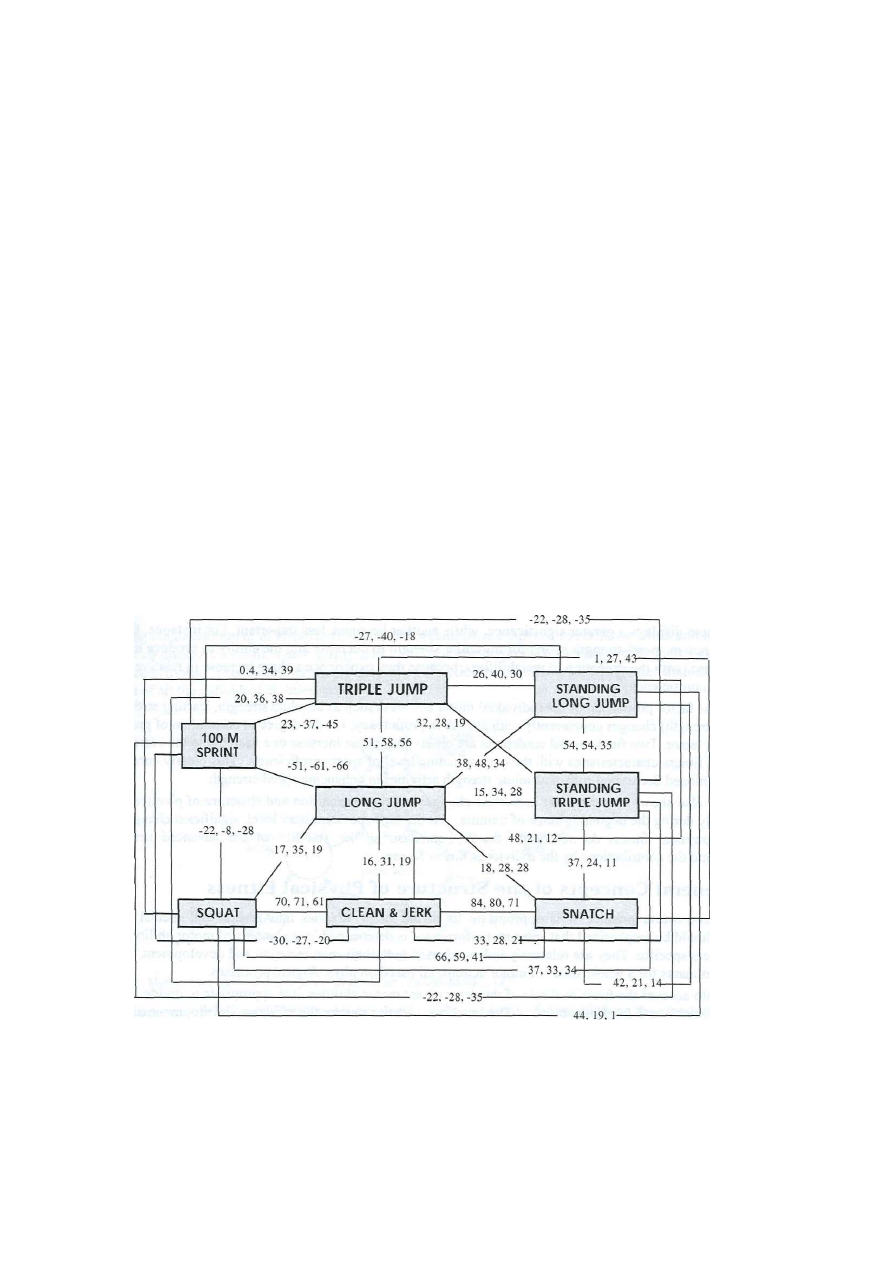
S UPERTRAINING
In the initial stages of training, the principle that 'all means are effective', is justified. However, as far as the
development of physical fitness is concerned, the negative correlations between abilities appear more strongly than
they should, but owing to the third ability, they level out. Levelling proceeds according to a principle of
averaging, because of which the optimal correspondence between a number of abilities is achieved, facilitated by a
decrease in both the direct and indirect connections (Verkhoshansky, 1977).
For example, the negative correlation between the 100m and the 1500m runs becomes even more apparent in
decathlon athletes as the level of proficiency grows. However, because of the improvement in the ability to run
400m, this correlation levels out by a decrease in the closeness of the connection between running the 400m and
1500m, while it increases between the 100m and 400m run.
Direct and indirect connections between abilities display the smallest qualitative changes. They always
characterise the structure of physical fitness, they are its specific properties, and changes are primarily
quantitative. From the standpoint of quantitative changes, the connections between the individual abilities display
two principal trends (Verkhoshansky, 1977):
• a decrease or increase in the closeness of the connection
• a linear or non-linear change of its indicators.
These trends may be illustrated concisely by means of a model of the correlational structure of the specific
physical fitness of triple jumpers (Fig 2.24). This model analyses the connection between performance tests to
determine the level of the jumper's sprinting, strength and jumping fitness.
The interconnecting lines between boxes in the diagram give the three coefficients of correlation (expressed as a
percentage) relating to the performances of three groups of athletes of different levels of mastery in the triple
jump. The first correlation coefficient refers to the jumping range of 13.50-14.49m for group 1, the second to the
range of 14.50-15.49m for group 2, and the last to the range of 15.50-16.70m for group 3, respectively (there were
40 men in each group).
Figure 2.24 Con-elation flowchart of exercises for special physical preparedness of triple jumpers. The group of three numbers in each
case refers to the correlation coefficient expressed as a percentage for triple junipers of increasing levels of sports mastery (Class 3 , 2 , 1,
respectively). (Siff & Verkhoshansky, 1999).
118

S UPERTRAINING
2.3.3 The Structure of Motor Abilities
Very interesting data for understanding the structure of physical fitness were obtained in studies using factor
analysis in a complex of tests to assess the motor abilities of junior and senior athletes of different levels of
qualification in a variety of sports (Verkhoshansky, 1977). The experimental data of training for various lengths of
time of one group of athletes was analysed in specific cases. The factor structure of the athlete's physical fitness
in a specific event, as well as the important changes in the structure connected with the growth in sports
proficiency, were examined.
The number of factors increases with growth in proficiency and are distinguished from the average
characteristics by which motor abilities are assessed. This is expressed in the separation of one or two factors. For
example, the change in the structure of physical fitness of triple jumpers with growth in proficiency is -'nected
with subdivision of the first factor into separate components (a 30m sprint, a standing long jump ant ding
triple jump). Thus, if the factor composition of a junior jumper's physical fitness can be identific ¿rial
sprint-jump fitness and strength fitness, then a new factor must be added for more advanced jumpers, namely
explosive jumping strength (the specific factor).
The division of one relatively general, primary motor ability into two specific abilities is typical of the process
of forming the structure of the athlete's physical fitness (Verkhoshansky, 1977). For instance, practical
investigations have analysed the separation of the snatch and the clean-and-jerk from squats and clean pulls as
performance indicators in weightlifting, the separation of absolute strength and relative strength as indices of
performance in volleyball, and the separation of the abilities to run with a running start and a regular start, as well
as running 30m and 100m from a regular start in sprinting and jumping.
Factor analysis enables one to quantitatively assess the contribution of each factor in the general profile of
factors. This method was used to observe the changes in the relative importance of a specific factor with growth in
proficiency. It has been established that, concurrent with the change in the factor composition (and consequently
the motor abilities which determine sporting success), there is a definite overestimation of their significance as
proficiency grows.
One of them displays a greater significance, while another becomes less important. For instance, there is a
general tendency in speed-strength sports for muscular strength to decrease and the ability to produce explosive
force to increase (with the exception of weightlifters, because they experience a sharp increase in relative strength
with growth in proficiency).
The fitness factor proportion of the individual motor abilities (such as absolute strength, starting strength and
acceleration strength) changes concurrently with growth in proficiency, i.e. the degree of correlation of proficiency
with the given factor. Two fundamental tendencies are observed here: an increase or a decrease in the correlation of
the individual fitness characteristics with the corresponding level of sports proficiency. This clearly corroborates
the above-mentioned decreasing role of absolute strength activities in enhancing speed-strength.
Research also shows that the most important changes in the composition and structure of physical fitness
occur primarily during the beginning stage of training. At the high sports mastery level, significant changes in the
structure of physical fitness do not occur, thereby emphasizing the stability of the advanced neuromotor
programmes and the contributions by the individual fitness factors.
2 . 3 . 4 General Concepts of the Structure of Physical Fitness
In research and sports practice it is appropriate to divide motor abilities into general and special abilities.
However, it should be emphasized that sporting performance is determined by a complex of motor abilities which
are qualitatively specific. They are relatively independent in both their manifestation and development, and may
serve as determinants for a whole series of motor actions, all based on physiological processes.
Taking into account the functional role of the determinant motor abilities, it is appropriate to divide them into
specific, non-specific and levelling abilities. The levelling abilities ensure the effective development of the key
motor ability, which expresses the motor requirements of the specific sporting action. The levelling abilities, as
will be seen later, balance out and smooth the interaction between all other abilities.
The role of specific abilities is to secure the productivity of the key motor abilities. The non-specific ability
does not satisfy the particular motor requirements and therefore participates as an assisting factor
(Verkhoshansky, 1977). The role of the non-specific ability becomes apparent where the specific ability is
displayed under difficult conditions. For example, if speed of movement (the specific ability) is the primary
119
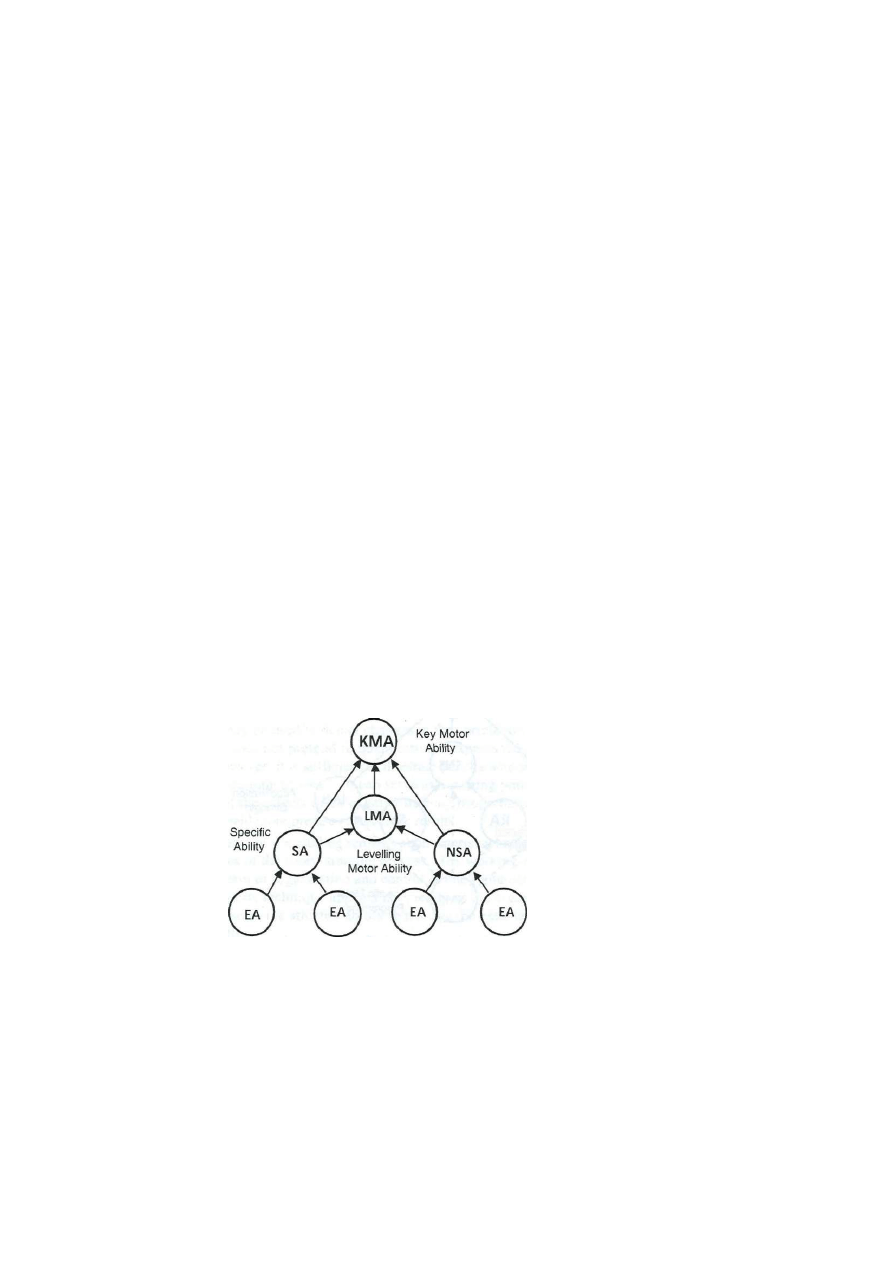
S UPERTRAINING
requirement, but displaying it to a high level is difficult because of external resistance, then muscular strength (the
non-specific ability) acts as an assisting factor. On the other hand, if the level of explosive strength decreases due
to increasing fatigue, for example, then the required motor effect can be maintained by special endurance processes.
The non-specific ability can often negatively affect the key motor ability. For example, the excessive
development of absolute strength has a negative influence on speed.
Levelling abilities play an important role in refining the key motor ability and in determining the structure of
general physical fitness. They smooth out clashes between the specific abilities and neutralise the influence of the
non-specific abilities if the latter act negatively against the specific abilities. Considering the diversity of motor
functions, where the formation of a whole series of non-specific motor abilities is possible, it should be recognized
that the levelling role of certain functions acquired by the body is vital for facilitating a high level of performance
under varying conditions.
Finally, it should be noted that determinant motor abilities display their own complex combination of the
elementary motor abilities. Thus, with respect to physical fitness, the key determinant abilities and the elementary
abilities should be distinguished hierarchically (Verkhoshansky, 1977). Based on studies of the types of
connections between abilities (see 2.3.2), the principal structure of physical fitness may be represented as follows
1. The key motor ability (KMA) is the result of the integrated development of a complex of determinants,
primarily the specific (SA) and non-specific (NSA) ability in each specific case.
2. The levelling motor abilities (LMA) participate in the process of motor integration as follows:
• to smooth out the negative correlation between specific and non-specific abilities
• to improve the connection between specific and non-specific abilities
• to expand the functional range and the accommodative potential of the key abilities.
3. Each of the determinant abilities is represented as a complex of elementary abilities (EA ).
Underlying the development of physical fitness is the organisational unity of the differentiation and integration of
the motor abilities. As a result, a new ability arises which is able to produce a strong working effect under a wide
range of conditions. This emerging ability displays a functional potential which is greater than the sum of the
properties of all the individual abilities.
Figure 2.25 Model of the physical preparedness of an athlete (Verkhoshansky, 1977).
The development of the specific motor abilities is one of the conditions for establishing the structure of physical
fitness. Before making assumptions about the mechanism of the specific motor abilities, it is necessary to consider
the following points (Verkhoshansky, 1977):
1. The elementary motor abilities are functionally independent, are not transformed into the key abilities
(specific) and preserve their own individuality with increase in fitness.
2. The specific motor ability (for example, explosive-strength) is, in general, largely an innate property of the
motor apparatus.
(Fig 2.25):
Nori-Specific
Ability
Elementary Abilities
120
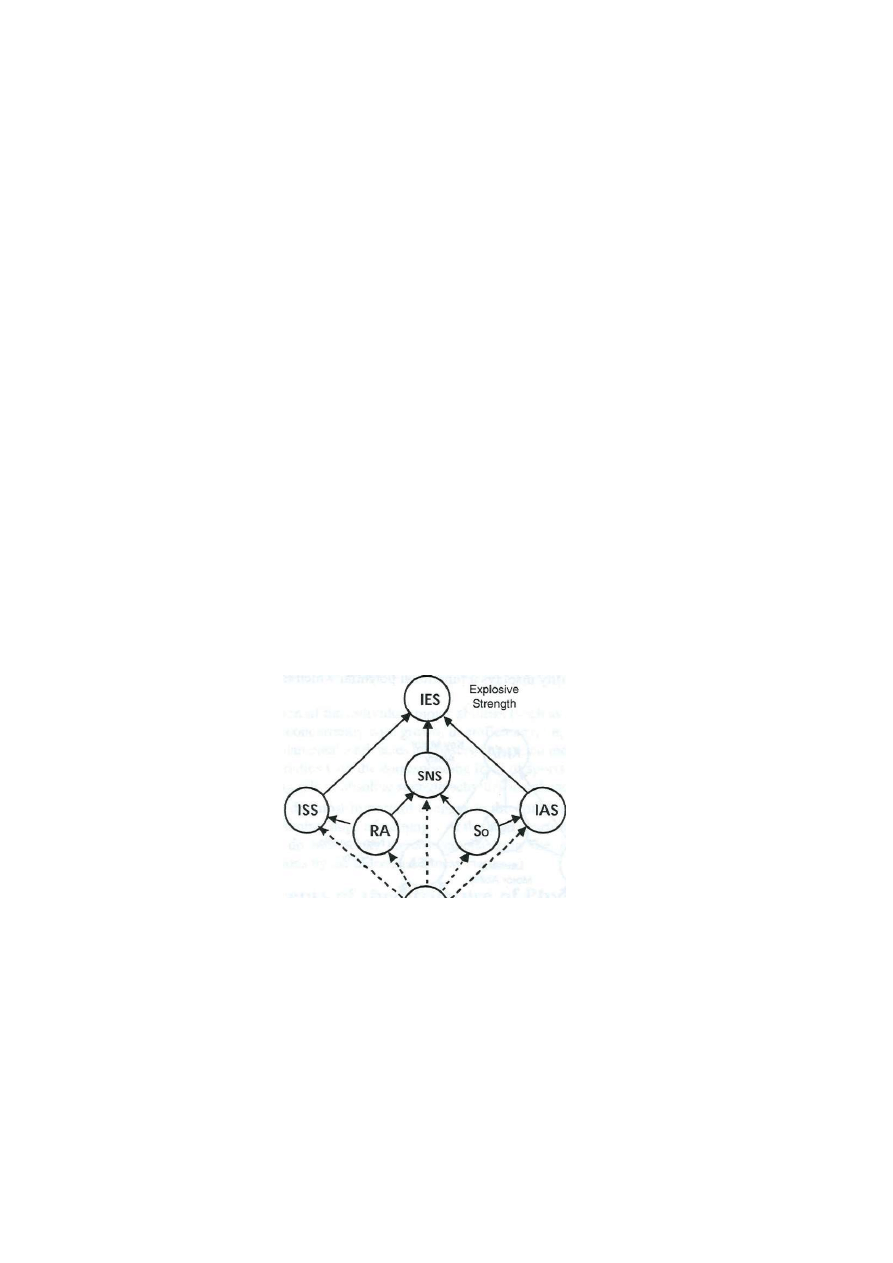
S UPERTRAINING
3. The specific motor ability is developed only by a particular motor regime.
Two hypotheses arise here: either the specific motor ability is functionally unrelated to the elementary motor
abilities or it is determined by a specific neuromotor structure which integrates part of the mechanisms of the
separate elementary forms of the motor abilities into a functional whole.
It is difficult to accept the former hypothesis. Research and practical experience indicate that the formation
and development of specific motor abilities is not based upon the synthesis of the motor abilities developed
individually or the gradual transformation of some abilities into others. Instead, motor abilities retain their separate
characteristics and a specific neuromotor programme is established by rational training which integrates the
contributions of other motor abilities.
This hypothesis can be expressed in the form of the principal scheme of the structure of explosive strength
(Fig 2.26). This scheme emphasizes that the development of this ability, occurs under the control of a specific
motor programme (SMP), which influences the components of explosive strength (starting strength, absolute
strength, acceleration-strength, and the reactive ability to quickly produce unloaded movement, RA), and forms its
specific neuromuscular structure (SNS). The latter is the fundamental condition for developing explosive strength,
its specific neuromuscular structure displaying a particular functional form.
It should be noted that there is a principal distinction between the mechanism which forms the structure of
physical fitness as a whole, and the mechanism of the key and specific motor abilities. In the former case, the
advantageous process of integration forms the foundation; in the latter case, the process of adaptive perfecting
already possesses a functional structure. The structure of physical fitness and the key motor ability is more
flexible and is formed on the basis of the wide diversity of the motor regimen. The specific motor abilities are more
conservative and their neuromuscular structure is developed only by a narrow range of means.
It is necessary to control the formation of the structure of physical fitness, a problem which is of exceptional
complexity in the theory of sport. This complexity is due to the fact that the physiological processes of
integrating the motor abilities is as yet not sufficiently clear. Therefore, it is extremely important to determine the
statistical characteristics of the structure of physical fitness to serve as the basis for objectively assessing and
controlling factors which influence it.
Figure 2.26 M o d e l of t h e specific motor structure of explosive strength. RA is the reactive ability to q u i c k l y p r o d u c e unloaded
movement, So is absolute strength and SNS is the Specific Neuromuscular Structure (Verkhoshansky, 1977).
So, the material examined in this chapter indicates that adaptation in sport seems to display various contradictions.
This is displayed by tendencies such as the integrative and separating character of the adaptive reaction, the
generality and specificity of adaptation, and the unity of divergent and convergent processes during adaptation.
The tendencies mentioned express themselves in the local specialisation of the motor apparatus and the
intensive development of specific motor abilities against the background of an increase in performance
(Verkhoshansky, 1977). Functional adaptation begins with the body as a whole, then proceeds according to two
interdependent paths, namely general adaptation and specific adaptation. At the same time adaptation develops
independently because of the differentiating and separating character of physiological processes.
Starting
Strength
( S M P l Specific Motor
V
J Programme
Acceleration
Strength
121
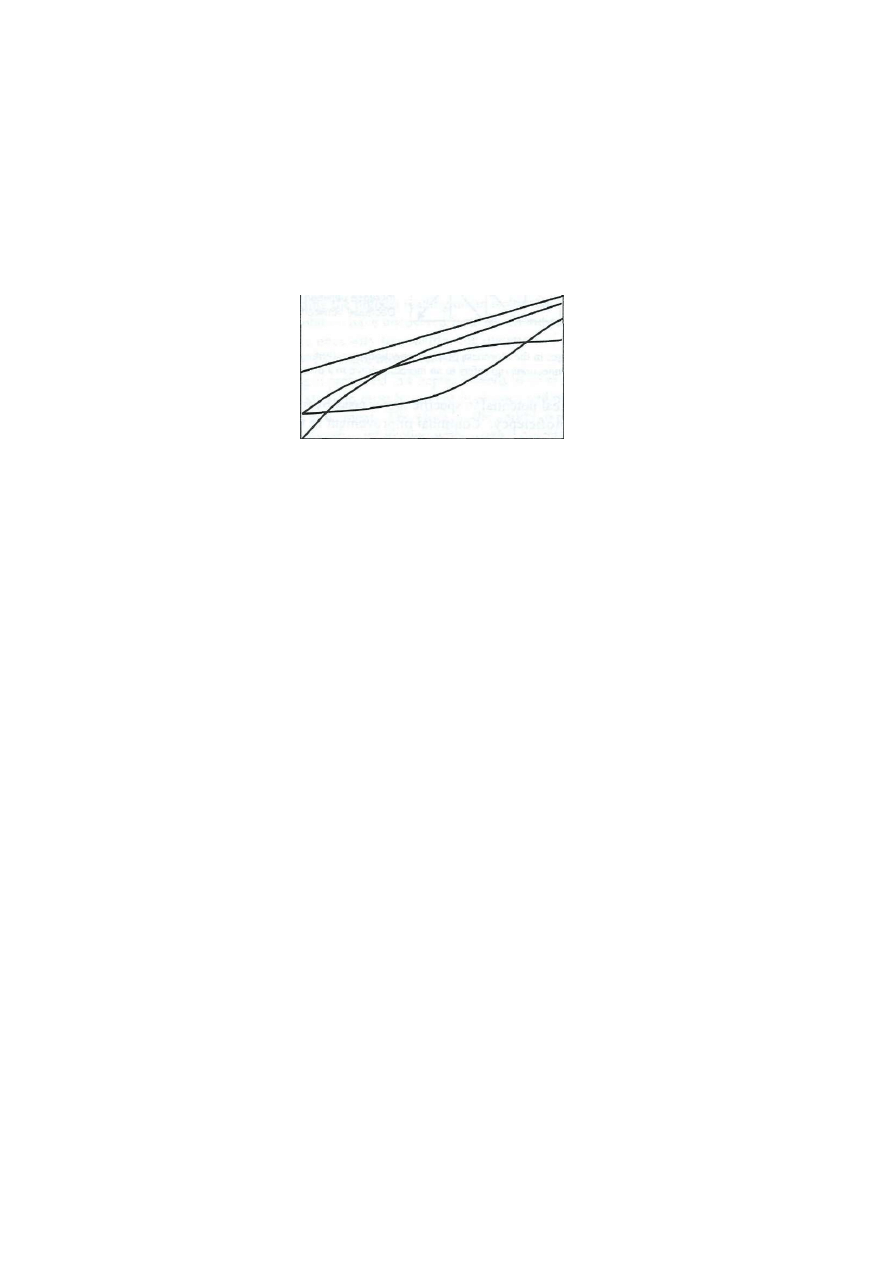
S UPERTRAINING
Observations of adaptation in the body and its external relationships during long-term training show that
measures of adaptive processes tend to correlate with sporting results (e.g. see 2.2.3). This assists in identifying
the most typical dynamic and structural regularities of the sports training process (Verkhoshansky, 1966, 1970).
The dynamics of the four fundamental components of sports proficiency relative to sports results (i.e. special
work-capacity, ability to utilise motor potential, general fitness and specific fitness), may be expressed by the
scheme illustrated in Figure 2.27.
Figure 2.27 Typical changes in the fundamental components of sports mastery over time. A is the athlete's special work capacity, B is
the athlete's ability to fully utilise his motor potential in sport, C refers to general fitness and D refers to special fitness.
(Verkhoshansky, 1977).
Growth of special work-capacity chiefly determines sporting success; it improves steadily and correlates linearly
with sports performance (A). Perfecting the ability to effectively utilise motor potential can be depicted as a
monotonically growing curve, converging asymmetrically on the line describing the increase in the key motor
ability (B). Improvement in the general work-capacity of the body can be expressed as a monotonically growing
curve (C), and special fitness as a sharply rising and plateauing parabola (D).
The closeness of correlation between the various components of sports mastery differentiates, and determines
to a large extent the motor specificity of the sporting movements (Verkhoshansky, 1977). Despite specific
differences between some components, a certain regularity is observed in the dynamics of certain connections
relative to improvement in performance. The principal changes in direction generally may be expressed graphically
in the form of a vector correlation matrix (Fig 2.28)
This scheme, which may be used to depict changes in the correlation between different components of sports
mastery in a given sport, does not pretend to quantitatively express the dependencies precisely and it probably
oversimplifies reality. However, it is sufficient to illustrate the characteristics of the dynamics of the fundamental
components of the sports training process. It can serve as a starting point for long-term planning of training and
as an ongoing indicator of the effects of an existing training programme, at least until there is a more rigorous
mathematical analysis to yield more precise and reliable results.
It is relevant to make a few concluding remarks about sports technique which results from recognising certain
regularities in the dynamics of the sports training process. The working-effect of a sporting movement is simply
the result of the specific form of organisation and control of one's interaction with the environment. However, the
fundamental concept of sports technique appears not merely as the organisation of the motor components of the
sporting movement, but also as the athlete's ability to manage the external conditions competently and exploit the
possibilities which they offer.
This ability is the result of many years of perfecting the motor functions and optimising use of all the body's
systems. If this is so, then sports technique is the result of a certain form of the process developing over time, and
consequently, as a specific scientific concept, it includes time coordinates. This determines an important principle,
namely that sports technique is not a constant which can be achieved once, but is the result of continued progress
from a lower to a higher level of perfection (Verkhoshansky, 1977).
This suggests that sports technique is widely understood in theory and practice as a means of solving motor
problems. Strictly speaking, sports technique is a system of movement, representing not so much a means of
solving motor problems, as the specific motor problem itself, which the athlete must solve every time he executes a
sports exercise. Consequently, sports technique consists of the search for and the learning of relevant motor
methods that provide the best way to use the one's motor potential.
A
B
c
D
LEVEL OF
TRAINABILITY
PROGRESS OF RESULTS
122

S UPERTRAINING
COMPONENTS
COMPONENTS
A1
A2
A3
B1
/
B2
\ \
B3
/
/
\
Increase between B1 & A1
Decrease between B2, A1, A2
Increase between B3. A1, A2
Decrease between B3 & A3
F i g u r e 2.28 Vector correlation matrix of changes in the closeness of the connections constituting the sports training process. The arrows
depict the trend in the changes of the various connections (up refers to an increase, down to a decrease). (Verkhoshansky, 1977).
Therefore, the ability to achieve one's real potential in specific motor tasks by maintaining a particular system of
movement is the essence of sporting proficiency. Continual improvement in this ability is fundamental to the
training process and the degree to which motor potential is realised is the criterion of its effectiveness.
123
Wyszukiwarka
Podobne podstrony:
I Supertraining Chapter 1 (2)
chapter 4 muscles, Prywatne, Materiały - Rok II, ang
ang chapter 1, Prywatne, Materiały - Rok II, ang
Prel II 7 szyny stałe i ruchome
Produkty przeciwwskazane w chorobach jelit II
Figures for chapter 5
9 Sieci komputerowe II
W wiatecznym nastroju II
W01(Patomorfologia) II Lek
Figures for chapter 12
Mała chirurgia II Sem IV MOD
Analiza czynnikowa II
PKM NOWY W T II 11
Ekonomia II ZACHOWANIA PROEKOLOGICZNE
Asembler ARM przyklady II
S Majka II Oś
Spotkanie z rodzicami II
więcej podobnych podstron